Frank F. Weber's Blog, page 19
March 4, 2018
Guilty, Even After Innocence is Proven
 Frank speaking at Minnesota State University in Mankato on his forensic work to Sociology and Criminal Justice students. Guilty, until proven innocent.
Frank speaking at Minnesota State University in Mankato on his forensic work to Sociology and Criminal Justice students. Guilty, until proven innocent.William George Heirens (November 15, 1928 – March 5, 2012) confessed to three murders in 1946. Heirens was called the Lipstick Killer after a notorious message scrawled in lipstick at a crime scene. On March 5, 2012, Heirens died at the age of 83 at the UIC Medical Center from complications arising from diabetes. At the time of his death, in 2012, Heirens was reputedly Chicago's longest-serving prisoner, having spent 65 years in prison.
Heirens had recanted his confession and claimed to be a victim of coercive interrogation and police brutality. You be the judge.

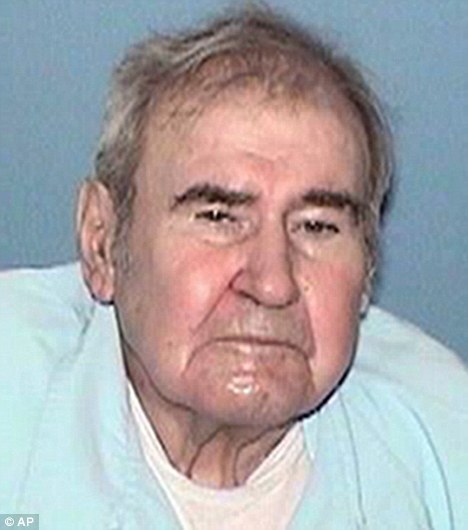 Early life
Early lifeWilliam Heirens grew up in Lincolnwood, a suburb of Chicago. He was the son of George and Margaret Heirens. George Heirens was the son of immigrants from Luxembourg and Margaret was a homemaker. His family was poor and his parents argued incessantly, leading Heirens to wander the streets to avoid listening to them. He took to crime and later claimed that he mostly stole for fun and to release tension. He never sold anything he had stolen.
At 13 years of age, Heirens was arrested for carrying a loaded gun. A subsequent search of the Heirens' home discovered a number of stolen weapons hidden in an unused storage shed on the roof of a nearby building along with furs, suits, cameras, radios and jewelry he had stolen. Heirens admitted to 11 burglaries and was sent to the Gibault School for wayward boys for several months.
Not long after his release, Heirens was again arrested for theft/larceny. This time, he was sentenced to three years at the St. Bede Academy, operated by Benedictine Monks. During his time at the school, Heirens stood out as an exceptional student excelling in all subject areas including but not limited to: mathematics, biological sciences, and social sciences. His test scores were so high he was urged to apply for the University of Chicago's special learning program. He was accepted into the program just before his release and asked to begin classes in the 1945 fall term, allowing him to bypass high school. He was 16 years old.
Heirens returned home to live and commuted to the university, but this was impractical, and he eventually boarded at the university's Gates Hall. His parents were unable to afford either the tuition or boarding, so Heirens worked several evenings a week as an usher and at the university to pay his way. However, he also resumed his serial burglary, even as he studied at the University of Chicago.
University of Chicago graduate Riva Berkovitz (PhD 1948) reports that Heirens was quite popular in the ballroom dancing class that they had together: “I remember the most popular boy in my class, who was handsome, smart and a good dancer. We all wanted to dance with him - the foxtrot, tango or a waltz. It didn't really matter."
Murders
Josephine Ross
On June 5, 1945, 43-year-old Josephine Ross was found dead in her apartment at 4108 North Kenmore Avenue, Chicago. She had been repeatedly stabbed, and her head was wrapped in a dress. She was presumed to have surprised an intruder, who then killed her. Dark hairs were found clutched in Ross' hand, indicating that she had struggled with the intruder before she was killed. No valuables were taken from the apartment.
Ross' fiancé had an alibi, as did her former boyfriends and ex-husbands, and police had no other suspects. They looked for a dark-complected man who was reported loitering at the apartment or running from the scene, but were unable to identify or locate him.
Frances Brown
On December 10, 1945, Frances Brown, a divorced woman, was discovered with a knife lodged in her neck and bullet wound to the head in her apartment at 3941 North Pine Grove Avenue, Chicago, after a cleaning woman heard a radio playing loudly and noted Brown's partly open door. Brown had been savagely stabbed, and authorities thought that a burglar had been discovered or interrupted. No valuables were taken, but someone had written a message in lipstick on the wall of Brown's apartment:
For heavens
Sake catch me
Before I kill more
I cannot control myself
Police found a bloody fingerprint smudge on the doorjamb of the entrance door. Also, there was a possible eyewitness to the killer's escape. An "eye-witness," George Weinberg, heard gunshots at about 4 am. According to John Derick, the night clerk stationed in the lobby of the building, a nervous man of 35–40 years old and weighing approximately 140 pounds got off the elevator, fumbled for the door to the street and left. (William Heirens, who was ultimately convicted of the murder, was 14 years old at the time.)
Four days after the murder, the Chicago Police announced they had reason to believe the killer was a woman.
Suzanne Degnan
On January 7, 1946, 6-year-old Suzanne Degnan was discovered missing from her first-floor bedroom in Edgewater, Chicago. Police found a ladder outside the girl's window, and a ransom note:
GeI $20,000 Reddy & wAITe foR WoRd. do NoT NoTify FBI oR Police. Bills IN 5's & 10's. BuRN This FoR heR SAfTY.
Acting on an anonymous tip, police discovered Suzanne's head in a sewer a block from the Degnan residence, her right leg in a catch basin, her torso in another storm drain, and her left leg in another drain. Her arms were found a month later in another sewer. Searches of an apartment building near where her head was found uncovered a basement laundry room with four tubs that contained evidence indicating she had been dismembered there. The killer had mopped the floor, but blood was found in the drains of all four tubs. The press called it the "Murder Room" although the autopsy showed that she had been alive when taken from her home, murdered at a second location that was never identified, and then taken to the laundry room.
Police questioned hundreds of people regarding the Degnan murder, and gave polygraph exams to about 170. On several occasions, authorities claimed to have captured the killer, but the suspects were eventually released.
Witnesses
Coroner Brodie fixed the time of death at between 12:30 and 1:00 am and stated that a very sharp knife had been used to expertly dismember the body. The site was later found to be in the basement laundry room at 5901 Winthrop Avenue, near the Degnans' home; however, it was determined that Suzanne was already dead when she was taken to the room. Dr. Kearns, the coroner's expert, stated that the killer was "either a man who worked in a profession that required the study of anatomy or one with a background in dissection...not even the average doctor could be as skillful, it had to be a meat cutter." Brodie concurred, adding that it was a "very clean job with absolutely no signs of hacking."
Hector Verburgh Arrest
The Chicago police were anxious to make an arrest. 65-year-old Hector Verburgh, a janitor in the building where Degnan lived, was arrested and touted as the suspect. Police told the press "This is the Man," despite discrepancies between Verburgh's profile and the one that was developed by them as to what kind of skills the killer had, including him having surgical knowledge or at least being a butcher. Police cited such evidence as Verburgh frequenting the so-called "Murder Room", and the grimy state of the ransom note suggested it was written by a dirty hand such as that of a janitor. The police pressured Verburgh's wife to implicate her husband in the murder.
Police held Verburgh for 48 hours of questioning, which included tying his hands and hanging him from the ceiling (which resulted in separating his shoulder), blindfolding him, and beating him. They also starved him. Throughout, Verburgh denied involvement in the murder and was ultimately released with the comment that a guilty man couldn’t have withstood the beatings. Hector stated after his release, “Any more and I would have confessed to anything.”
Verburgh sued the Chicago Police Department for $15,000 but was awarded $20,000, which is approximately $222,000 in today’s dollars. Five thousand dollars of the $20,000 awarded to Verburgh was awarded to his wife.
So the Chicago police still had 3 murders to solve.
Sidney Sherman Investigation
Another notable false lead was that of Sidney Sherman, a recently discharged Marine who had served in World War II. Police had found blonde hairs in the back of the Degnan apartment building. Near that was a handkerchief the police suspected might have been used as a gag to keep Suzanne quiet. On the handkerchief was a laundry mark name: S. Sherman. The police hoped that perhaps the killer had erred in leaving it behind. They searched military records and discovered that a Sidney Sherman lived at the Hyde Park YMCA. The police went to question Sherman but discovered that he had vacated the residence without checking out and quit his job without picking up his last paycheck.
A nation-wide manhunt ensued. Sherman was found four days later in Toledo, Ohio. He explained under interrogation that he had eloped with his girlfriend and denied that the handkerchief was his. He was administered a polygraph test, which he passed, and was later cleared. The handkerchief's real owner, Airman Seymour Sherman of New York City, was eventually found. He had been out of the country when Suzanne Degnan was murdered. He had no idea how it could possibly have ended up in Chicago and the presence of the handkerchief was determined to be a coincidence.
Lack of progress
In February 1946, Suzanne Degnan's arms were found by sewer workers about a half mile from her home. By this time, the press was taking an increasingly critical tone as to how the police were handling the Degnan investigation.
Phoenix Investigator offers promising lead
Richard Russell Thomas was a nurse living in Phoenix, Arizona, having moved from Chicago. At the time of the Chicago investigation, he was imprisoned in Phoenix for molesting one of his own daughters, but he was in Chicago at the time of the Degnan murder. A handwriting expert for the Phoenix Police Department first informed Chicago authorities of the "great similarities" between Thomas' handwriting and that of the Degnan ransom note, noting that many of the phrases Thomas had used in an extortion note were similar and his medical training as a nurse matched the profile suggested by police. Although Thomas lived on the south side, he frequented a car yard directly across the street from where Suzanne Degnan's arms were found. During questioning by Chicago police, he freely admitted killing Suzanne Degnan. However, the investigators were called back to Chicago, that very same day, with the report police in Chicago had arrested the killer.
A college student, William Heirens, was caught fleeing from the scene of a burglary, brandished a gun at police. During the foot pursuit, a fight ensued and Heirens got the better of the officer. While Heirens was on top of the officer, at the bottom of long stairwell below the street, an off-duty policeman witnessed the fight and dropped three clay flowerpots on Heirens's head, one at a time, from the top of the stairs, rendering him unconscious. Back in Phoenix, Richard Thomas now recanted his confession, but Thomas went unnoticed by the press in light of the new lead.
Arrest and Questioning of Heirens
On June 26, 1946, 17-year-old William Heirens was arrested. He remembered drifting into unconsciousness under questioning. The police had taken him to Bridewell Hospital, which was adjacent to the Cook County Jail. The questioning was violent.
Heirens later said he was interrogated around the clock for six consecutive days, being beaten by police and not allowed to eat or drink. The severity of this assault is not fully known, although it was known they burned his testicles with ether in an attempt to render a confession. Heirens was not allowed to see his parents for four days. He was also refused the opportunity to speak to a lawyer for six days. Two psychiatrists, Doctors Haines and Roy Grinker, gave Heirens sodium pentothal without a warrant and without Heirens' or his parents' consent. They interrogated him for three hours. Still he never confessed. Under the influence of the drug, authorities claimed, Heirens blamed someone, which the police concluded was an alternate personality of Heirens. When police asked for the last name he said he couldn't remember, but that it was "a murmuring name." Police translated this to "Murman" and the media later dramatized it to "Murder Man." What Heirens actually said is in dispute, as the original transcript disappeared. In 1952, Dr Grinker revealed that Heirens had never implicated himself in any of the killings.
On his fifth day in custody, Heirens was given a lumbar puncture (spinal tap) without anesthesia. Moments later, Heirens was driven to police headquarters for a polygraph test. They tried for a few minutes to administer the test, but it was rescheduled for several days later after they found him to be in too much pain to cooperate.
When the polygraph was administered, authorities, including State's Attorney William Tuohy, announced that the results were "inconclusive." On July 2, 1946, he was transferred to the Cook County Jail, where he was placed in the infirmary to recover from his physical injuries (that occurred in questioning).
Heirens's first confession
After the sodium pentothal questioning but before the polygraph exam, Heirens spoke to Captain Michael Ahern. With State's Attorney William Tuohy and a stenographer at hand, Heirens offered an indirect confession, confirming his claim while under sodium pentothal that his alter-ego might have been responsible for the crimes.
Authorities were skeptical regarding Heirens's claims and suspected that he was laying the groundwork for an insanity defense, but the confession earned widespread publicity with the press transforming "Murman" to "Murder Man.”
Hard evidence
While handwriting analysts did not definitively link Heirens's handwriting to the "Lipstick Message," police claimed that his fingerprints matched a print discovered at the scene of the Frances Brown murder. It was first reported as a "bloody smudge" on the doorjamb. Furthermore, a fingerprint of the left little finger also allegedly connected Heirens to the ransom note with nine points of comparison. As Heirens's nine points of comparison were loops, this could also provide a match to 65% of the population. At the time, Heirens's supporters pointed out the FBI handbook regarding fingerprint identification required 12 points of comparison matching to have a positive identification.
Contradictions from the police department: On June 30, 1946, Captain Emmett Evans had told newspapers that Heirens had been cleared of suspicion in the Brown murder, as the fingerprint left in the apartment was not his. Twelve days later, Chief of Detectives Walter Storms confirmed that the "bloody smudge" left on the doorjamb was Heirens'. The partial finger print on the ransom note, now contained Heirens full print, as if his finger was rolled finger print style on the document. One investigator later commented, “I’ve never seen this ( a full rolled fingerprint) again in any case.” The FBI suggested the chain of evidence had clearly been violated.
Loot
Police searches (without a warrant) of Heirens's residence and college dormitory found other items that earned publicity. Notably recovered was a scrapbook containing pictures of Nazi officials that belonged to a war veteran, Harry Gold, that was taken when Heirens burgled his place the night Suzanne Degnan was killed. Gold lived in the vicinity of the Degnans. This, once again, put Heirens in the circle of suspicion.
Also in Heirens's possession was a stolen copy of Psychopathia Sexualis (1886), Richard von Krafft-Ebing's famous study of sexual deviance. In addition, among Heirens's belongings police discovered a stolen medical kit, but they announced that the medical instruments could not be linked to the murders. No trace of biological material such as blood, skin or hair were found on the tools. Moreover, no biological material of the victims were found on Heirens himself or any of his clothes. The medical kit tools were considered to be too fine and small to be used for dissection. Instead, Heirens had used the four-inch-long medical kit to alter the war bonds he stole. A gun was found in his possession that was linked to a shooting. A Colt Police Positive revolver had been stolen in a burglary at the apartment of Guy Rodrick on December 3, 1945. Two nights later, a bullet crashed through the closed eighth-floor apartment window of Marion Caldwell, wounding her. Heirens had that gun in his possession and, according to the Chicago Police Department, the bullet that injured Caldwell was linked through ballistics to that same gun.
Press influence
Without evidence, the press convicted Wlliian Heirens. As Time observed in its July 29, 1946, issue:
The News and Hearst's Herald-American hit the street together with front-page layouts showing William Heirens as a Dr. Jekyll (hair combed) and Mr. Hyde (hair mussed). He had not yet been charged with murder, but the Tribune airily convicted him:
On July 16, 1946, Chicago Tribune staff reporter George Wright wrote a piece on the case titled "The Heirens Story! How He Killed Suzanne Degnan and 2 Women." Wright manufactured details and cited "unimpeachable sources" that said Heirens had confessed. The Tribune devoted 38 columns to the story. It began:
This is the story of how William George Heirens, 17, kidnapped, strangled and then dismembered Suzanne Degnan, 6, last Jan. 7, and distributed the parts of her body in sewer openings near her home. It is the story of how William George Heirens climbed into the apartment of Miss Frances Brown...and shot and stabbed her to death, and left a message on the wall with lipstick imploring the police to catch him...And it is the story of how William George Heirens entered the apartment of Mrs. Josephine Ross...and how he stabbed her to death when she awoke.
A radio newscast reported on the Chicago Tribune's scoop of the "confession," which Heirens heard in his cell. He was incredulous, stating:
I didn't confess to anybody, honestly! My God, what are they going to pin on me next?
State's Attorney Tuohy also absolutely denied that Heirens had made a confession. Regardless, the other four competing daily newspapers reprinted the Tribune alleged confession in their publications with Chicago newspapers headlining the story 157 times over the next ten weeks. As The Tribune wrote later:
So great was public confidence in the Tribune, that other newspapers ... reprinted the story solely because the Tribune said it was so. . . . For a while, Heirens maintained his innocence. But the whole world believed his guilt. The Tribune had said he was guilty.
As late as 1975, the Chicago Daily News was still taking credit for its "scoop."
Second confession
Heirens's defense attorneys "felt" their task was to save Heirens from the electric chair. Heirens was kept in a cell, several feet from the electric chair. The prosecutor, on the other hand, was not certain he could get a conviction.
The prosecutor prompted the state's attorney's office to seek out an agreement with defense counsel, pointing out that all they honestly had in the Degnan case was a partial fingerprint that matched 65% of the population on the ransom note.
Heirens's lawyers pressured him to take a plea bargain. The deal, which was the topic of that closed-door meeting with Prosecuter Tuohy, stated that Heirens would serve one life sentence if he confessed to the murders of Josephine Ross, Frances Brown, and Suzanne Degnan. With the help of his lawyers, he began drafting a confession using the Chicago Tribune article on the murders as a guide: William Heirens stated, “If I made a mistake, they would say, 'Now, Bill, is that really the way it happened?' Then I would change my story because, obviously, it went against what was known (in the Tribune)."
Both Heirens and his parents signed a confession. The parties agreed to a date of July 30 for Heirens to make his official confession. On that date, the defense went to Tuohy's office, where several reporters were assembled to ask Heirens questions and where the prosecutor made a speech.
Angry over it all, Heirens stated, “If you want the truth, I didn’t do it. I was being forced to lie to save myself. It made me angry...so I told them the truth, and everyone got very upset." Tuohy withdrew the previously agreed sentence and threatened Heirens with the death penalty if he went to trial. They threatened to charge him with another murder (Estelle Carey) even though Heirens was attending the Gibault School for Wayward Boys, a boarding school in Terre Haute, Indiana, at the time.
The Chicago Tribune headline read "Mute Heirens Faces Trial - Killer Spurns Mother's Fervent Plea to Talk."
Guilty plea
Heirens took full responsibility for the three murders on August 7, 1946. The prosecution had him reenact the crime in the Degnan home in public and in front of the press. On September 4, with Heirens's parents and the victims' families attending and Chief Justice Harold G. Ward presiding, Heirens admitted his guilt on the burglary and murder charges. That night, Heirens tried to hang himself in his cell, timed to coincide during a shift change of the prison guards. He was discovered before he died. He said later that despair drove him to attempt suicide:
Everyone believed I was guilty...If I weren't alive, I felt I could avoid being judged guilty by the law and thereby gain some victory. But I wasn't successful even at that...Before I walked into the courtroom my counsel told me to just enter a plea of guilty and keep my mouth shut afterward. I didn't even have a trial...
Heirens agreed with the new plea agreement. Heirens said later: "I confessed to save my life."
As Heirens waited to be transferred to Stateville Prison from the Cook County Jail, Sheriff Michael Mulcahy asked Heirens if Suzanne Degnan suffered when she was killed. Heirens answered: “I can't tell you if she suffered, Sheriff Mulcahy. I didn't kill her. Tell Mr. Degnan to please look after his other daughter, because whoever killed Suzanne is still out there.”
It’s important to note that after all of this had occurred, William Heirens still hadn’t turned 18 years old.
Claims of Innocence
Within days of his confession in open court, Heirens denied any responsibility for the murders. Mary Jane Blanchard, daughter of murder victim Josephine Ross, was one of the first dissenters, being quoted in 1946 as saying:
I cannot believe that young Heirens murdered my mother. He just does not fit into the picture of my mother's death ... I have looked at all the things Heirens stole and there was nothing of my mother's things among them.
Polygraph test
In 1946, after Heirens underwent two polygraph examinations, Prosecutor Tuohy declared the results inconclusive. However, John E. Reid and Fred E. Inbau published the test findings in their 1953 textbook, Lie Detection and Criminal Interrogation, which seem to contradict that assertion. According to the book, the test was not inconclusive, writing, "Murderer William Heirens was questioned about the killing and dismemberment of six-year old Suzanne Degnan ... On the basis of the conventional testing theory his response on the card test clearly establishes (him) as an innocent person."
Handwriting evidence
Four separate handwriting experts, both attached to the Chicago police and independent at the time of the original investigation, believed that Heirens had no connections to either the note or the wall scribble. Independent handwriting expert George W. Schwartz was brought in to give his opinion. He stated flatly that "The individual characteristics in the two writings do not compare in any respect."
So let’s talk about an alternative suspect
After the Degnan murder, but before Heirens became a suspect, Chicago police interrogated 42-year-old Richard Russell Thomas, in Phoenix, a drifter passing through the city of Chicago at the time of Degnan's murder, found in the Maricopa County Jail in Phoenix, Arizona. Police handwriting expert Charles B. Arnold, head of the forgery detail of the Phoenix police in Thomas's hometown of Phoenix, noted similarities between the handwritten Degnan ransom note and Thomas' handwriting when Thomas wrote with his left hand, and suggested that Chicago police investigate Thomas.
Upon being questioned, Thomas confessed to the crime, but he was released from custody after Heirens became the prime suspect. Others contend that Thomas was a strong suspect, to wit:
• Thomas previously had been convicted of an attempted extortion – with a ransom note that threatened the kidnapping of a little girl.
• As previously noted, handwriting experts at the time stated that the Thomas's ransom note from his previous conviction of extortion bears similarity in both style in regard to the wording and in form of the actual structure of the letters formed to the Degnan ransom note.
• Thomas was in Chicago at the time of the Degnan murder.
• At the time he confessed to the Degnan crime, he was awaiting sentencing for molesting his daughter.
• Thomas had a history of violence, including spousal abuse. Thomas was a nurse who was known to masquerade as a surgeon. He often boasted to his friends that he was a doctor and he was known to steal surgical supplies. Chicago Police had previously developed a profile of the Degnan killer as having surgical skills or being a butcher.
• He frequented a car agency near the Degnan residence. Parts of Suzanne Degnan's body were found in a sewer across the street from the car agency.
• Like Heirens, he was a known burglar.
• He had confessed freely to the Degnan murder, although he later recanted.
The Chicago detectives dismissed Thomas' claims after Heirens became a suspect. Thomas died in 1974 in an Arizona prison. His prison record and most of the evidence of his interrogation regarding the Chicago murders have been lost or destroyed.
Aftermath
Soon after Heirens was arrested, his parents and younger brother changed their surname to "Hill." His parents divorced after his conviction.
Heirens was first housed at Stateville Prison in Joliet, Illinois. He learned several trades, including electronics and television and radio repair, and at one point he had his own repair shop in the prison. Before a college education was available to prison inmates, Heirens, on February 6, 1972, became the first prisoner in Illinois history to earn a four-year college degree, receiving a Bachelor of Arts (BA) degree, later earning 250 course credits by funding the cost of correspondence courses with 20 different universities from his savings. Passing courses as varied as languages, analytical geometry, data processing and tailoring, he was forbidden by authorities to take courses in physics, chemistry or (my favorite banned course) celestial navigation. He managed the garment factory at Stateville for five years, overseeing 350 inmates, and after transfer to Vienna he set up their entire educational program. He aided other prisoners' educational progress by helping them earn their General Educational Development (GED) diplomas and becoming a "jailhouse lawyer" of sorts, helping them with their appeals.
Heirens should have been discharged from the Brown murder in 1975 and from all remaining charges in 1983. However, in 1973 the focus moved from rehabilitation to punishment and deterrence, which blocked moves to release Heirens. In 1983, the Seventh District U.S. Court of Appeals ruled that it was unconstitutional to refuse parole on deterrence grounds to inmates convicted before 1973. Magistrate Gerald Cohn ordered Illinois to release Heirens immediately. The brother and sister of Suzanne Degnan went public, pleading with authorities to fight the ruling. Attorney General Neil Hartigan stated "Only God and Heirens know how many other women he murdered. Now a bleeding-heart do-gooder decides that Heirens is rehabilitated and should go free ... I'm going to make sure that kill-crazed animal stays where he is," a sentiment supported by the media. The Illinois Senate passed a resolution that as the "confessed murderer of Suzanne Degnan, a 6-year-old girl whom he strangled in 1946 ... that it is the opinion of the chamber that the release of William Heirens at this time would be detrimental to the best interests of the people of the state." With the support of prominent politicians, the 1983 court ruling was later reversed.
In 2002, Lawrence C. Marshall, et al., filed a petition on Heirens's behalf seeking clemency. The appeal was eventually denied.
Death
After being taken to the University of Illinois Medical Center on February 26, 2012, due to complications from diabetes, Heirens died on March 5, 2012, at the age of 83. This is a case where a juvenile coming out of poverty had no access to justice, even though he was intelligent. Cases like this are important to know about, so we can take steps to prevent similar injustice from re-occurring.
Quotes:
Action speaks louder than words but not nearly as often. Mark Twain
Why is it that if you take advantage of a tax break, you're a smart businessman, but if you take advantage of something you need to not be hungry, you're a moocher?" Jon Stewart
When white people wear baggy clothing and speak gibberish they're homeless, when black people wear baggy clothing and speak gibberish they're called rappers. Carlos Mencia
I went to a bookstore and asked the saleswoman, 'Where's the self-help section?' She said if she told me, it would defeat the purpose. George Carlin
Thanks for listening,
Frank I never thought I’d say, I really like a Tom T. Hall song, until I heard, “That’s how I got to Memphis.” I definitely have to catch the Avett Brothers in the near future. Here is their version of it.








 More shots of winter in MN from last week.
More shots of winter in MN from last week.  Michael and Kristin Weber
Michael and Kristin Weber  John, Frank and Charlie decide to play a little Cheap Trick and Bob Seger in the wee hours of the morning following Michael and Kristin Weber’s wedding in Moorhead, with a room full of family singing along. It was nice to have Mitch, Breck and Aaron step in and play tunes to keep us from getting dehydrated. It is wonderful to celebrate weddings with friends and family—precious moments!
John, Frank and Charlie decide to play a little Cheap Trick and Bob Seger in the wee hours of the morning following Michael and Kristin Weber’s wedding in Moorhead, with a room full of family singing along. It was nice to have Mitch, Breck and Aaron step in and play tunes to keep us from getting dehydrated. It is wonderful to celebrate weddings with friends and family—precious moments! 






























Published on March 04, 2018 12:28
February 26, 2018
Packers Drafted a Serial Killer in 1974
 First of all, I’d like to thank the Minnesota Community Corrections Association for a great conference. I presented in a room meant to hold 40 at the St. Cloud Convention Center, and we squeezed 60 in. Professionals stayed for my presentation, even though it meant some had to sit on the floor. I am so thankful to be received so well.
First of all, I’d like to thank the Minnesota Community Corrections Association for a great conference. I presented in a room meant to hold 40 at the St. Cloud Convention Center, and we squeezed 60 in. Professionals stayed for my presentation, even though it meant some had to sit on the floor. I am so thankful to be received so well. 


 Winter in Minnesota can be beautiful. I took these pictures on 2/22/2018.
Winter in Minnesota can be beautiful. I took these pictures on 2/22/2018.  Randall Woodfield’s life is best characterized by self-centeredness and a lack of accountability. The I-5 killer has recently been suspected of the homicide of University of Minnesota student Mary Schlais on February 15, 1974. Mary was hitchhiking on Highway 94 to an arts convention in Chicago. Her body was discovered in Springbrook township in Wisconsin. Investigators have determined Woodfield was traveling from Portland to Green Bay at the time of Mary’s murder. He fits the same description that a witness gave of the man who dumped the body. Mary also fits his prototype of Woodfield’s victims — all of his victims were young and petite, white women.
Randall Woodfield’s life is best characterized by self-centeredness and a lack of accountability. The I-5 killer has recently been suspected of the homicide of University of Minnesota student Mary Schlais on February 15, 1974. Mary was hitchhiking on Highway 94 to an arts convention in Chicago. Her body was discovered in Springbrook township in Wisconsin. Investigators have determined Woodfield was traveling from Portland to Green Bay at the time of Mary’s murder. He fits the same description that a witness gave of the man who dumped the body. Mary also fits his prototype of Woodfield’s victims — all of his victims were young and petite, white women.In high school, Randall Woodfield was caught standing on a bridge and exposing himself to females. His parents sent him to a therapist, who, by all accounts, were not overly concerned by a teenager exploring his sexuality. Newport High’s coaches knew about the situation but, wanting to protect their star, chalked it up to an adolescent’s lapse in impulse control. Police say that when Woodfield turned 18, his juvenile record was expunged. At college in Portland State University in Oregon, he was described “as a little strange.” As a player, the biggest concern was his unwillingness to go over the middle to catch passes. He didn’t like getting hit. I would like to point out that even though charges weren’t coming forth, I don’t believe his sex crimes stopped. A former PSU teammate stated, “You just had a bad feeling about the guy, like there was something underneath his mask.” Says Carey, Woodfield’s quarterback, “I was surprised when some of this stuff started coming down, but on reflection, I thought, that does sort of add up.”
Randall was drafted by the Packers, but cut. Their explanation was they were going to focus on the run game. The Wisconsin police suggested he was cut after numerous reports of indecent exposure began to emerge. (Randall was never formally charged.)
Woodfield remained in Wisconsin, settling an hour and a half west in Oshkosh, where he played for the semipro Manitowoc Chiefs and moonlighted as a press-brake operator. (Ironically, Manitowoc is the setting for the acclaimed 2015 Netflix documentary Making a Murderer.) While he would have preferred to spend his Sundays at Lambeau, Woodfield felt that playing on Saturdays nearby for the Chiefs, the Packers execs might notice him and reconsider their decision.
Teammates from that stop recall Woodfield as a “smooth operator,” a “ladies man” and a bit strange. Fred Auclair, a teammate and roommate, recalls Woodfield bringing home a trinket he had acquired at a local Christian bookstore. “How much was that?” Auclair inquired. “Well,” said Woodfield, “it wasn’t really for sale, so I stole it.” Woodfield, adds Auclair, “was on the phone all the time, telling tall tales. He had a woman in every port, it seemed.”
After the season, though, Woodfield was dropped by the Chiefs. No reason was given publicly. There were murmurs, however, of off-field concerns. Woodfield was involved in at least 10 cases of indecent exposure across the state (but never charged). So despite Woodfield’s history, at this point he has no sex crimes on his record, which means no accountability and no treatment efforts.
By multiple accounts, Randall Woodfield was devastated by being cut by the Packers. Woodfield seemed to know there would be no more invitations from other teams. With his ambitions of being a pro football player ended, he drove back to the West Coast.
In early 1975, Portland police were vexed by a series of attacks on women, carried out by a man—invariably described as athletically built and handsome—armed with a knife. After demanding oral sex he would take a woman’s purse or wallet and run off. On March 5, detectives set up a sting operation. An undercover female officer walked leisurely through a park, and a man wielding a paring knife darted out from behind some bushes demanding money. Officers converged and arrested Randall Woodfield.
Charged with robbery, Woodfield gave an extensive interview to police. He admitted to some impulse-control issues and some “sexual problems.” And he confessed to one vice: He’d taken steroids to augment his physique. Maybe, he speculated, that changed his sex drive.
“There was a conventional wisdom back in the day that someone who was an exposer or a Peeping Tom wouldn’t elevate to more serious crimes,” says Paul Weatheroy, a longtime Portland cold case detective. “We’ve learned that nothing’s further from the truth.”
Woodfield cruised around Portland in a gold 1974 “Champagne Edition” Volkswagen Beetle and took unmistakable pride in his physique. He was especially fond of sending naked photos of himself to women. In late ’79, Woodfield was photographed in a state of undress, his abundant muscles abundantly oiled. He mailed the image to Playgirl for consideration. The following May, he received a letter back: “Congratulations! You have been selected for possible publication in Playgirl’s Guy Next Door feature.”
On Oct. 11, 1980, Cherie Ayers, an attractive 29-year-old, was found raped, stabbed and bludgeoned to death in her Portland apartment. According to the coroner, she died from blunt-force trauma and knife wounds to her neck. Ayers and Woodfield were former classmates at Newport High, who had reconnected at their 10 year reunion. This is his earliest–verified murder. He had known Cherie Ayers since childhood.
When homicide detectives questioned Woodfield, they found his answers “evasive” and “deceptive,” But he declined to take a polygraph. In a time predating reliable DNA testing, there was no other physical evidence.
Seven weeks later, Darcey Fix, 22, and Doug Altig, 24, were shot to death, execution-style and with a .32 revolver, in Fix’s Portland home. Again Woodfield had a connection to the murdered woman: One of his closest friends—a teammate from PSU’s track team—had dated Fix. Again Woodfield was questioned, but police had nothing concrete linking him to the murders. (New DNA testing has implicated Woodfield in the murders.)
Between 1980 and 1981, Woodfield committed multiple murders in cities along the I-5 corridor in Washington, Oregon, and California. On Dec. 9, 1980, a man wearing a fake beard held up a gas station in Vancouver, Washington, just across the Columbia River from Portland. Four nights later, in Eugene, Oregon, a man wearing a fake beard and what looked like athletic tape on his nose raided an ice cream parlor. The next night, a drive-in restaurant in nearby Albany, Oregon, was robbed by a bearded man. A week after that, in Seattle, a gunman matching the same description pinned down a 25-year-old waitress inside a restroom and sexually assaulted her. Four weeks later, Shari Hull, age 20, and Lisa Garcia, age 20, were sexually assaulted and shot in central Oregon.
Word began spreading that an “I-5 Bandit” was marauding up and down the northern half of Interstate 5, a ribbon running parallel to the Pacific for the 1400 miles between the Mexican and Canadian borders. All of the crimes occurred within two miles of an interstate exit.
On Feb. 3, 1981, Donna Eckard, 37, and her 14-year-old daughter, Jannell Jarvis, were found dead in their home in Mountain Gate, Calif., just off I-5. Each had been shot multiple times in the head. Lab tests would later reveal that the girl had been sodomized. Earlier that same day, an 18-year-old waitress was kidnapped and raped after a holdup 15 miles to the south, in Redding. The next day, a similar crime was reported 100 miles up I-5 in Yreka, Calif.
By then, word of the I-5 Bandit had amplified to the point that women were being warned to exercise caution. On Valentine’s Day 1981, Candee Wilson implored her 18-year-old daughter, Julie Reitz, to “be careful—there’s a dangerous person out there.” Later that night, Julie was shot and killed at their home in Beaverton, Oregon. She had known Woodfield previously. In his job as a bouncer he had overlooked her fake ID and let her into a bar. (New DNA evidence implicates Randall Woodfield.)
From one act to the next, the descriptions were remarkably similar: An athletic man, armed with a silver .32 revolver and wearing tape over his nose, abducted a woman, committed a sexual act and then shot her execution-style.
The I-5 killer’s downfall came swiftly and without much drama. A persistent detective, Dave Kominek, led the investigation. He worked in the sheriff’s office of Marion County, Ore., where Hull had been murdered, and he had his suspect pegged early on. Kominek knew Woodfield was acquainted with multiple victims. Woodfield knew his way around the I-5 corridor, and he matched the physical description provided by multiple witnesses. What’s more, Marion County detectives put together a pay-phone call log that showed Woodfield using calling cards within a few miles of the murders. Woodfield was arrested in March 1981.
After Lisa Garcia picked Woodfield’s photo out of a lineup, police interrogated him on March 5, 1981. They searched his residence—a room he had been renting from an unsuspecting family in Springfield, Oregon, and found telling evidence: the same brand of tape that had been used to bind victims and a .32 bullet in Woodfield’s racquetball bag.
Four days later, police charged him with Hull’s murder, Garcia’s attempted murder and two counts of sodomy. Woodfield, employing a public defender, entered a plea of not guilty. By March 16, indictments were rolling in from various jurisdictions in Washington and Oregon, including multiple counts of murder, rape, sodomy, attempted kidnapping, armed robbery and possession of firearms by an ex-convict.
When Woodfield’s trial for the incident with Hull and Garcia began in the summer of 1981, it marked the first murder trial for an earnest, fledgling Marion County prosecutor named Chris Van Dyke (whose famous father, Dick, had recently finished up a run on The Carol Burnett Show). At the time, the prosecutor characterized Woodfield as “an arrogant, cold, unemotional individual . . . probably the coldest, most detached defendant I’ve ever seen.” By his own reckoning, Van Dyke had “armloads of evidence, overwhelming evidence.” Bizarrely, Woodfield admitted in court to having owned a .32 pistol but said that when he’d learned that as a parolee it was a violation to own a firearm, he threw the gun into a river.
Lisa Garcia, meanwhile, was the key witness, recalling the horrific night at the office building five months earlier. She maintained that the man she faced in the courtroom was the same man who, she alleged, shot her and killed her coworker. It took the jury 31⁄2 hours to reach its verdict.
On June 26, 1981, Randall Woodfield was convicted on all counts. With no death penalty option in Oregon, Woodfield, then 30, was sentenced to a prison term of life, plus 90 years. That December, 35 more years were added to his sentence when a jury in Benton County, Oregon, convicted him of sodomy and weapons charges tied to another attack in a restaurant bathroom.
District attorneys up and down the I-5 corridor had a decision to make. Even if they could secure a conviction, what would be the point? Woodfield was already almost certain to die in prison. Additional trials would drain their offices of time and resources and would put the victims’ families through an excruciating ordeal. Even in California—where Woodfield was accused of killing a mother and her daughter, and where the death penalty would have been an option—the local prosecutor eventually decided against pursuing Woodfield.
Still, the list of his victims has grown. In 2012, detectives in the Portland Police Bureau’s cold case unit, benefiting from new magnetic bead technology at the Oregon state police crime lab, announced they had matched Woodfield’s DNA to evidence from five victims: Fix, Jarvis, Eckard, Altig, and Reitz.
In July 2005, on account of similar DNA matches, the former Portland lieutenant, Paul Weatheroy, and cold case supervisor, interrogated Woodfield about his connection to the unsolved crimes. “I remember that his hair was perfect, feathered and combed; he had a perfectly even tan, nails manicured,” says Weatheroy. “He was very charismatic, which makes sense because he would lure victims and get them to let their guard down.” Woodfield, though, confessed to nothing.
Ultimately, as in other jurisdictions, authorities in Portland’s Multnomah County decided not to prosecute the murders of Altig, Ayers and Fix. They did, however, hold a press conference to make clear: In the unlikely event that Woodfield was ever granted a parole hearing, they would pursue these additional indictments.
Jim Lawrence, another detective in Portland’s cold case unit was struck most by Woodfield’s lack of accountability or remorse—even in the face of indisputable evidence. “If Woodfield were, somehow, to be paroled tomorrow? “He would re-offend, there’s no doubt about it,” says Lawrence. “Even to this day, he is still a stone-cold killer.”
Randall Woodfield was 30 years old when he was arrested-- a terrible person, who should have been in the system far sooner. He is now 67. Thirty-eight years after his conviction, he sits in Oregon State Penitentiary, nestled among Douglas firs and the Cascades, located in Salem, barely a mile from I-5.
What disturbs me the most is that people spoke up for him to get him in the NFL, and there is no evidence he was ever a decent person. He had sex offenses as a juvenile and an adult, that he never received charges for. He raped and killed frequently as an adult, finally being incarcerated at age 30.
The following is a list of Woodfield's confirmed victims: Woodfield is also estimated to have committed at least 60 unsolved rapes.
1980October 9: Cherie Ayers (29): A former classmate of Woodfield's; was found in her Portland home on October 11; was bludgeoned and stabbed multiple times in the neck.November 27: Darci Fix (22) and Doug Altig (24): Both found shot to death with a .32 revolver in Altig's Portland home.December 21: Unnamed woman (25): Assaulted at gunpoint in a Seattle restroom and sexually assaulted; survived.
1981January 11: Susie Benet (20): A market clerk in Sutherlin, Oregon, shot by Woodfield during robbery; survived.January 18: Shari Hull (20) and Lisa Garcia (20): Employees at a TransAmerica office in Keizer, Oregon, accosted by Woodfield during their evening work shift; sexually assaulted both women before shooting them each in the head. Hull died of her injuries; Garcia survived.February 3: Unnamed woman (18): Kidnapped at gunpoint and raped near Redding, California in the morning hours; survived.February 3: Donna Eckard (37) and daughter Janelle Jarvis (14): Both found sexually assaulted and shot to death in their Shasta County home. Jarvis was determined to have been sodomized after death.February 4: Unnamed woman: Kidnapped and raped in Yreka; survived.February 15: Julie Reitz (18): Raped and shot to death in her Beaverton, Oregon home around 4 a.m. was an acquaintance of Woodfield's through his job as a bouncer.
Quotes:
A person who has never gone to school steals from a freight car; but with a university education, you can steal the whole railroad. Theodore Roosevelt
When I dance, people think I’m looking for my keys. Ray Romano
People who dance are considered crazy be people who can’t hear. George Carlin
All my life I thought air was free, until I bought a bag of chips.
Thanks for listening,
Frank
Rod Stewart and The Faces played the best blues music I still have ever heard back in the 1970’s. My brothers know the argument, as I made them listen to it (at least the rock tunes) when they were growing up. Here is Rod singing a song he wrote back in that era, “I Don’t Want to Talk About It” with Aimee Belle. Like most Stewart concerts, the audience takes over the chorus for part of the song. Aimee sings it better, but I thank Stewart for bringing it to us.






















Published on February 26, 2018 06:52
February 19, 2018
Big MACCAC Attack!
 Brothers Tone and the Big Groove performed a sold out Valentines concert at the Great River Arts Center in Little Falls Frank Weber is speaking at MACCAC (Minnesota Association of Community Corrections Act Counties) conference, at the St. Cloud Convention Center, this Thursday, February 22, 2018, from 8:00 to 10:00 am. After the Broward County school shooting President Trump was quick to point out it is a mental health issue, rather than a gun issue. Last year I presented on MACCAC on the crisis mental illness is presenting to corrections. (Maybe I was a year early.) I had just reached a point where I wanted to say to lawmakers, “Wake up and open your eyes.”
Brothers Tone and the Big Groove performed a sold out Valentines concert at the Great River Arts Center in Little Falls Frank Weber is speaking at MACCAC (Minnesota Association of Community Corrections Act Counties) conference, at the St. Cloud Convention Center, this Thursday, February 22, 2018, from 8:00 to 10:00 am. After the Broward County school shooting President Trump was quick to point out it is a mental health issue, rather than a gun issue. Last year I presented on MACCAC on the crisis mental illness is presenting to corrections. (Maybe I was a year early.) I had just reached a point where I wanted to say to lawmakers, “Wake up and open your eyes.”Did you know that the most common way people are accessing mental health services today is by being arrested? As a society we lack crisis mental health services and we need to consider solutions as it costs us lives and more money in the long run. Ask anyone who works in corrections. They deal with it every day.
This year, instead of giving an overview of a problem, I decided to offer some practical advice on addressing impulsive decision making. But I still have to add, every time an issue comes up, we hear, “This is not the government’s job.” So before I get started, let me offer this: If it’s not the government's job to regulate industry, provide education and healthcare, or to protect its citizens from threats, just what is the government's job?
 Addressing Impulsive Decision Making with Mentally Ill/Antisocial Offenders at the MACCAC (Minnesota Association of Community Corrections Act Counties) conference. St. Cloud Convention Center, February 22, 2018. 8:00 to 10:00 am
Addressing Impulsive Decision Making with Mentally Ill/Antisocial Offenders at the MACCAC (Minnesota Association of Community Corrections Act Counties) conference. St. Cloud Convention Center, February 22, 2018. 8:00 to 10:00 amFrank Weber, M.S./L.P., Clinical Director of CORE Professional Services, PA
Frankweberauthor.com
CORE (320) 202-1400 frankw@coretreatment.com
 “Between stimulus and response there is a space. In that space is our power to choose our response. In our response lies our growth and our freedom.”
“Between stimulus and response there is a space. In that space is our power to choose our response. In our response lies our growth and our freedom.” ― Viktor E. Frankl
“Every characteristic absence of spirituality, every piece of common vulgarity, is due to an inability to resist a stimulus - you have to react, you follow every impulse.”
― Friedrich Nietzsche , The Anti-Christ/Ecce Homo/Twilight of the Idols/Other Writings
It’s essential to remain calm in emotional times.
 Impulsive decision making can lead to:Financial instabilityGambling/financial lossDishonestyProperty damageSelf-injuryAssaultLegal charges for theft/DWI/substance use/assaultSubstance relapseProbation violationsUncommitted sex/damaged relationshipsDeviant sexual behaviorPregnancy/sexually transmitted infectionsHigh risk situations
Impulsive decision making can lead to:Financial instabilityGambling/financial lossDishonestyProperty damageSelf-injuryAssaultLegal charges for theft/DWI/substance use/assaultSubstance relapseProbation violationsUncommitted sex/damaged relationshipsDeviant sexual behaviorPregnancy/sexually transmitted infectionsHigh risk situations Story: Assessment question: What year did you graduate from high school? Answer: “The 12th year.”
Critical thinking levels: (Taken from Allison King’s Designing Critical Thinking)
People operate at 3 different levels of reasoning:
Story: I loved looking at the way my children, and now grandchild, problem solve, although my 4 year old granddaughter warned me, “No more tricky questions, and I’m done talking about love.” Favorite story is when she asked a couple in their 80’s “Are you two doing okay?”
 1. Pre-reflective = “If it feels good, do it.”
1. Pre-reflective = “If it feels good, do it.”  2. Quasi-reflective = You only pay attention to evidence that supports what you believe (confirmation bias). Unfortunately, many people don’t get beyond this.
2. Quasi-reflective = You only pay attention to evidence that supports what you believe (confirmation bias). Unfortunately, many people don’t get beyond this.  3. Reflective thinking = You consider what you desire, but also weigh the consequences of that choice and reason through it. You take into account “Is this a step toward becoming the person I want to be?”
3. Reflective thinking = You consider what you desire, but also weigh the consequences of that choice and reason through it. You take into account “Is this a step toward becoming the person I want to be?”  Dialectical reasoning involves considering a contradictory option to what’s desired. Most people aren’t able to use reflective thinking until they are adults. Here’s an example:
Dialectical reasoning involves considering a contradictory option to what’s desired. Most people aren’t able to use reflective thinking until they are adults. Here’s an example:Belief: I desire to be at this party-- even though there are underage people drinking alcohol and illegal drugs. I will have fun. I can control my substance use.
Contradictory Belief: My life and my values go beyond what I want. I don’t need to immediately have what I want. (I have matured beyond the age of 2.) Everybody has restrictions and I’d be a fool not respect mine. (As a therapist I have a window in my office for protection from an allegation.) If I had a criminal charge, I’d want to respect my restrictions because I’d want to stay out of jail. I’d want to keep my promises to people who stood by me. (Reframing involves thinking about the situation differently. This isn’t going to be a blast. Instead, it’s a criminal charge waiting to happen.) The intelligent choice is to leave. I will have fun other ways.
 Impulse control is the process of learning to stop and consider the consequences of your actions, before acting. You can avoid making an impulsive decision by immediately telling yourself:
Impulse control is the process of learning to stop and consider the consequences of your actions, before acting. You can avoid making an impulsive decision by immediately telling yourself:Not right now.I need time to think about it.I can’t right now, because I’m leaving right away.
Developmental psychologist, Lev Vygotsky, believes we learn best through guided participation, or in other words, having someone walk through the problem with us. In Japan, if a student is struggling with a math problem, the instructor states, “This is really hard for us,” implying it’s both a problem for the learner and the teacher. + It emphasized the importance of helping people work through failure. As a teacher, try to find the goodness in them. People who feel appreciated, are more motivated.
Consider: I could have made it harder to make an impulsive decision by:Waiting an hour and reconsidering.Make myself do this (positive) task first.Make a list of the pros and cons first.Consider the decision making abilities of people in the environment.Ask, “What will I lose if I make this decision?”If I want to have a large amount of money (or something nice), I can’t spend my money every time I have a small amount.Say, “I am not indestructible,” and list the potential consequences for this choice. Example: head injury, pregnancy, overdose, arrest, a charge that reduces my opportunities for employment.
Story: The new DeBeers diamond ad suggests you buy a ring with 2 diamonds on it—1 for your lover, 1 for your best friend. A late night comedian commented,”I had to call my best friend and get that diamond back. I guess they were both supposed to be for my wife.
Quieting or Controlling your mind
Step 1
Discharge the extra energy & wear yourself out.
 You have no control over your thoughts. Thoughts feel like they “just happen.” The mind runs amuck, often causing misery and terrible choices. The point of meditation, yoga, distance walking or running, or any endurance or mindfulness task is to put the mind under your control… rather than allowing your mind to control you. It’s like a sport for your mind.
You have no control over your thoughts. Thoughts feel like they “just happen.” The mind runs amuck, often causing misery and terrible choices. The point of meditation, yoga, distance walking or running, or any endurance or mindfulness task is to put the mind under your control… rather than allowing your mind to control you. It’s like a sport for your mind.  My favorite way to learn to “quiet” the mind is to wear it out. A long walk works for me. Other people run. Some lift weights until he they’re physically exhausted. Running on the treadmill, or elliptical, or playing an exhausting basketball game would do the trick too.
My favorite way to learn to “quiet” the mind is to wear it out. A long walk works for me. Other people run. Some lift weights until he they’re physically exhausted. Running on the treadmill, or elliptical, or playing an exhausting basketball game would do the trick too. Step 2
Accept your thoughts as guidance toward resolution (even if they’re troubling).
 Step 2, is best done when the mind is already a little relaxed by things like the above… or could happen with Step 1 if the person is well-practiced at it, is learning to control and focus the mind. So, yoga, meditation, mindful eating (where you focus on each bite, or sip of tea), deep breathing, progressive relaxation, etc. Get the mind under your control. The point is NOT to “not think.” The point is to notice WHAT you think. What thoughts keep coming back? What are you sending your mental energy too? Are they helpful thoughts? Why those thoughts? Are you worried? Self-loathing? Depressed about the past? Anxious about the future? This step is insight building.
Step 2, is best done when the mind is already a little relaxed by things like the above… or could happen with Step 1 if the person is well-practiced at it, is learning to control and focus the mind. So, yoga, meditation, mindful eating (where you focus on each bite, or sip of tea), deep breathing, progressive relaxation, etc. Get the mind under your control. The point is NOT to “not think.” The point is to notice WHAT you think. What thoughts keep coming back? What are you sending your mental energy too? Are they helpful thoughts? Why those thoughts? Are you worried? Self-loathing? Depressed about the past? Anxious about the future? This step is insight building. Step 3
Use your mind to pose the right questions.
 Step 3, involves making the mind your friend, your coach, your teacher. Learn to listen to your inner wisdom. Learn to think the right thoughts and pose the right questions to yourself. Quiet your mind so you can focus on the decision over environmental influences (stop multi-tasking and step away from the situation or electronics and focus on the choice):Ask, “What is the downside to making this decision?”Ask, “Will this decision benefit me?”Ask, “How would my mom or dad, or partner, feel if I made this decision?”Ask, “Is this decision consistent with my values and how I see myself as a person?”Ask, “How will I feel about this decision one year from now?” Eventually, that year will be today.Ask, “How will people treat my family (parents, siblings, children, partner) if I make this decision?”Ask, “Would my grandmother approve of this decision?”Ask, “Does this decision have the potential to become a bad habit?”
Step 3, involves making the mind your friend, your coach, your teacher. Learn to listen to your inner wisdom. Learn to think the right thoughts and pose the right questions to yourself. Quiet your mind so you can focus on the decision over environmental influences (stop multi-tasking and step away from the situation or electronics and focus on the choice):Ask, “What is the downside to making this decision?”Ask, “Will this decision benefit me?”Ask, “How would my mom or dad, or partner, feel if I made this decision?”Ask, “Is this decision consistent with my values and how I see myself as a person?”Ask, “How will I feel about this decision one year from now?” Eventually, that year will be today.Ask, “How will people treat my family (parents, siblings, children, partner) if I make this decision?”Ask, “Would my grandmother approve of this decision?”Ask, “Does this decision have the potential to become a bad habit?”  To help with impulsive anger:
To help with impulsive anger:Story: I helped a man of Mexican ancestry today who is a great worker, but he struggles a little with English. He works at a factory and applied for a promotion working on a new machine. He's the guy people go to fix the machines and he cleans anytime he isn't busy, thinking "anything to help the company." His coworkers thought he was a shoe-in for the job, but instead it went to another guy who has been fired 3 times for being incompetent. I've talked to him about how frustrating situations are opportunities to show we don't respond like everyone else. He was proud of how he handled it.
He went to his boss and asked why he didn't receive the promotion.
His boss responded by teasing, "Your English isn't too good."
He asked his boss to follow him to the machine. He then stood there silent next to it. When his boss started talking he said, "Shhhhhhhhhhhhhhh..."
After a bit his boss said, "You realize this machine doesn't talk?"
He told his boss, "Yeah, I just wanted to make sure you realized this."
 Obstacles are an opportunity to distinguish ourselves. We don’t have to react like everyone else.Following an emotional encounter, write out your thoughts and don’t allow yourself to respond until tomorrow.
Obstacles are an opportunity to distinguish ourselves. We don’t have to react like everyone else.Following an emotional encounter, write out your thoughts and don’t allow yourself to respond until tomorrow.I had a client do this who found, most of the things he gets angry about were the result of comments he misunderstood, and there really was nothing to do about them. This process enabled him to both keep his job, and take things less personally.Tell myself, “Shut up,” so I don’t say something I’ll regret. We want to say something immediately, but we almost never have to. Consider the amount of time it will take to fix the relationship after the comment. Is it worth it?
Would you still make the comment if you just gave yourself an hour to think about it?Walk away and calm down, or go for a drive and play some music. (The first book on anger written in the 1800’s suggested we walk in a straight line when we’re angry and don’t turn back until we’ve calmed down.)Would the situation be better if I didn’t respond?When face to face with a difficult person, tell yourself, “God put people like you on this earth to prove I can be a decent person.”
 Values are standards people live their life by.
Values are standards people live their life by. Beliefs can become Values when commitment to it grows. So people start with beliefs but can later convert them to values.
We have values as an individual. Values as a couple. Values as a family.
Our values can come in conflict and at that point we need to decide which values are most important to us. Is it more important to be a decent person or to be loyal? There are people like Socrates, Jesus, Ghandi, Muhammed, Confucious and Guatama Buddha who believe that some values are universal. An example of values:
 Reliability = Are you going to be there for your partner or your children?
Reliability = Are you going to be there for your partner or your children?Commitment = to relationship or family
 Honesty = Are you a person of your word?
Honesty = Are you a person of your word?Kindness = kindness is something you do for others
 Loyalty = may be something you do for you. I appreciate loyalty, but I don’t value loyalty over kindness. Is it false pride? (Something you claim to have pride about, but you really shouldn’t be proud of.) For example: Gangs and dysfunctional families engage in a lot of hurtful behavior in the name of loyalty.
Loyalty = may be something you do for you. I appreciate loyalty, but I don’t value loyalty over kindness. Is it false pride? (Something you claim to have pride about, but you really shouldn’t be proud of.) For example: Gangs and dysfunctional families engage in a lot of hurtful behavior in the name of loyalty.  Compassion = understanding the suffering of others
Compassion = understanding the suffering of others  Fairness and Equality = everyone deserves to be treated with respect
Fairness and Equality = everyone deserves to be treated with respect  Respect = sharing consideration for the worth of someone
Respect = sharing consideration for the worth of someoneIt’s not diamonds that are your best friend, but best friends who are your diamonds.
Be a friend to someone you work with.
Know the value of time. (This means both use time wisely, and take time to listen.) At this moment, you could be kind to someone.
Value yourself.
My wife’s grandmother, Mae Gross, was one of the most amazing people I’ve ever met. She was a farmer’s wife--not particularly well-educated. But whenever you had a conversation with her, you felt important. I should be that gifted.
Recognize when people are doing things right—at home, at work, people you help, etc. This reinforcement is your most powerful tool. (It works on us.)
Basic Values Questions:
 In what situation would you have sex with another person? Love. Affection. Attention. Any moving object. Your answer to this question is descriptive of the person you are.
In what situation would you have sex with another person? Love. Affection. Attention. Any moving object. Your answer to this question is descriptive of the person you are.  Is it okay to degrade others? We all need to laugh, but be weary of jokes that target groups. Is pornography okay? Would it be okay if it was a family member? Don’t we have a responsibility to care for everybody, even people who don’t take care of themselves?
Is it okay to degrade others? We all need to laugh, but be weary of jokes that target groups. Is pornography okay? Would it be okay if it was a family member? Don’t we have a responsibility to care for everybody, even people who don’t take care of themselves?  What are your values regarding alcohol use, marijuana and other illegal drugs? When would you know you were using too much? Where do you draw the line?
What are your values regarding alcohol use, marijuana and other illegal drugs? When would you know you were using too much? Where do you draw the line?  In what situation would you hit another person? Anger. Insult. Self-Defense.
In what situation would you hit another person? Anger. Insult. Self-Defense.  How important is family to you? How often do you talk to them? When’s the last time you’ve helped a family member?
How important is family to you? How often do you talk to them? When’s the last time you’ve helped a family member?How do you leave an environment? Better. As you entered it. Trashed out.
 When do you offer to listen to others? Too busy. Convenient. Set times. Too often.
When do you offer to listen to others? Too busy. Convenient. Set times. Too often.  How is your spirituality evident to others? Many of us believe there is something larger that connects all of us. Attend church. At work. At home. In your relationship. The manner in which you treat others.
How is your spirituality evident to others? Many of us believe there is something larger that connects all of us. Attend church. At work. At home. In your relationship. The manner in which you treat others. Don’t let anyone tell you they’re not responsible for their behavior. It’s an insult to their intelligence and integrity.
 I can safety plan for situations that create poor impulsive decisions (consider how I’m going to respond to the risks before I go into the situation):If I’m approached to drink, I will say, “No thank you, I need to stay sober today.” I will then speak to someone who is not drinking.If drugs are around, I’ll leave and I will go home (You always hear, “Something is better than nothing,” well doing nothing is better than doing some things).Before I buy an item, I will force myself to return to the store on another day to purchase it, so I have time to consider the consequences of purchasing it.Attention is nice, but I am not that shallow that I need to pursue a relationship every time someone gives me attention.Set a schedule of things I need to get done today and follow through.Is this decision consistent with my values? What kind of person am I if I make this decision?I am no different than anybody else. Everyone has temptation. What separates good people from others is their willingness to make good choices when faced with temptation.Apologize for past poor impulsive decisions. This will help you avoid making this decision again. Take pride in making decisions that avoid poor impulsive choices. (This is important. We battle temptation. Give yourself credit for winning. Reinforcing behavior results in repeating the behavior.)
I can safety plan for situations that create poor impulsive decisions (consider how I’m going to respond to the risks before I go into the situation):If I’m approached to drink, I will say, “No thank you, I need to stay sober today.” I will then speak to someone who is not drinking.If drugs are around, I’ll leave and I will go home (You always hear, “Something is better than nothing,” well doing nothing is better than doing some things).Before I buy an item, I will force myself to return to the store on another day to purchase it, so I have time to consider the consequences of purchasing it.Attention is nice, but I am not that shallow that I need to pursue a relationship every time someone gives me attention.Set a schedule of things I need to get done today and follow through.Is this decision consistent with my values? What kind of person am I if I make this decision?I am no different than anybody else. Everyone has temptation. What separates good people from others is their willingness to make good choices when faced with temptation.Apologize for past poor impulsive decisions. This will help you avoid making this decision again. Take pride in making decisions that avoid poor impulsive choices. (This is important. We battle temptation. Give yourself credit for winning. Reinforcing behavior results in repeating the behavior.)  Develop healthy habits (reducing stress reduces impulsivity):ExerciseEat healthyTalk to healthy people (support group)Be kind to peopleReligious involvementSet time to study and learnHealthy reflection time or yoga
Develop healthy habits (reducing stress reduces impulsivity):ExerciseEat healthyTalk to healthy people (support group)Be kind to peopleReligious involvementSet time to study and learnHealthy reflection time or yoga Conclusions:
Here are my last suggestions for people who struggle with impulsive decision making.If it’s a good idea, it will still be a good idea in 48 hours.Consult with two healthy people before making the decision.People treat us today based on the choices we made three months ago. How do you want people to treat you three months from now? If you want respect, make respectful choices.Scan the environment. What are the risks? Do you trust the people here to make good choices in this situation?
 Quotes:
Quotes:If con is the opposite of pro, then isn’t Congress the opposite of progress?
Jon Stewart
The star of Cake Boss was arrested for DWI. Police interrogated him for 30 minutes at 350 degrees.
Joe Toplyn
The Onion Headline:
Parents are choosing not to learn the gender of their obstetrician until after the child is born.
This is a conversation that occurred in my brother’s home.
Wife: “What are you watching?”
Husband: “I’m watching an ID show where the wife kills her husband. Do you want me to record it?”
Wife: “Does she get away with it?”
Husband: “No.”
Wife: “Then don’t bother.”
Thanks for listening,
Frank Weber Pictures of our family back in 1989.

























Published on February 19, 2018 06:40
February 10, 2018
The Boston Strangler
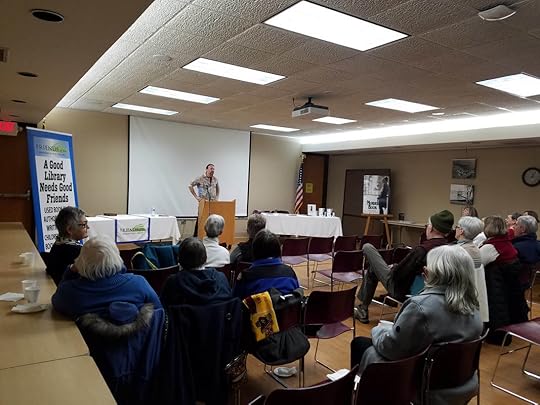 Frank speaking at the “brown bag event” at the Brainerd Public Library
Frank speaking at the “brown bag event” at the Brainerd Public Library 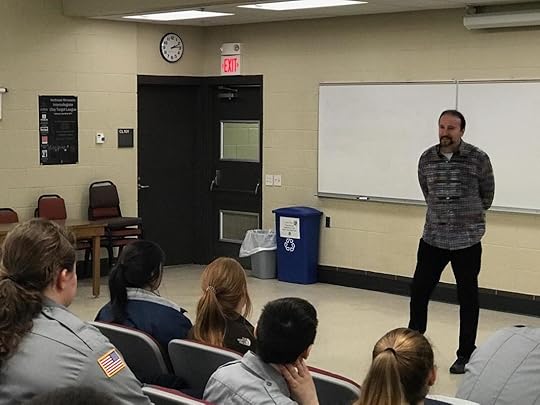 Frank speaking to Critical Skills law enforcement class at Vermillion Community College
Frank speaking to Critical Skills law enforcement class at Vermillion Community College 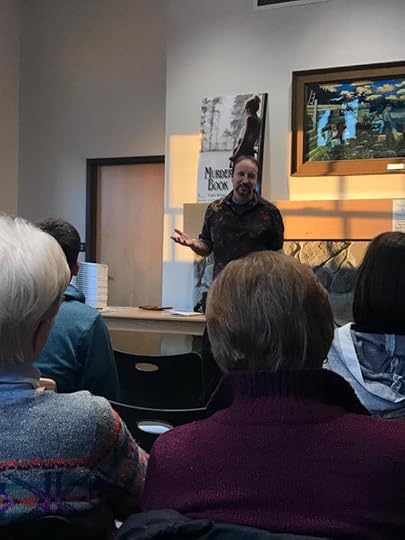 Frank speaking at Ely Public Library on Murder Book
Frank speaking at Ely Public Library on Murder Book Albert DeSalvo was born September 3, 1931 in Chelsea, Massachusetts, and was murdered in prison on November 25, 1973 in Walpole, Massachusetts. There are those who feel DeSalvo was unfairly tagged the Boston Strangler, because he loved attention and confessed to it. After reviewing the evidence, I believe Desalvo was the Boston Strangler.
Chelsea was the poorest city in Massachusetts, and Albert was born during the Great Depression. Albert DeSalvo was born to Frank and Charlotte DeSalvo. Frank DeSalvo was a crazy abusive father who knocked all of his wife’s teeth out and broke all of her fingers purposely in front of the children. Frank DeSalvo also brought prostitutes home and had sex with them in front of his children. Albert’s brother recalled their father lifting Albert up by the neck and choking him while Albert's limbs dangled.
When Albert was young, age 10, his siblings shared how he helped them get food to eat. There was a time when he seemed salvageable, but a significant change occurred after he experienced puberty. In addition to having a crazy abusive father, they had neighbors who had parties and engaged in sex on a couch on the roof, which Albert watched. Albert was cruel to animals as a child. At age 12, he beat up a paper boy and robbed him of $2. He was given a slap on the hand and was released. Two weeks later, he was arrested again for robbery and this time the judge sent him to the Lyman School for Boys for 2 years. Albert was paroled in 1944. In 1946, Albert was returned to the Lyman school after he was arrested for stealing an automobile. DeSalvo joined the army and received an honorable discharge. (Keep in mind all young males were in the military back then.) Albert was noted to have an obsession with cleanliness while in the military. He recommitted, and despite being tried in a court martial, he was given an honorable discharge again. Albert married Imgard Beck while stationed in Germany. She later revealed Albert had an insatiable appetite for sex and would request sex 5 or 6 times a day. DeSalvo would frequently go into the bathroom and masturbate after they had sex. Albert later stated he had burning feeling in his abdomen and felt he had to have sex with someone. He was arrested during his marriage for carnal abuse of a child. The girl’s mother felt testifying would be too hard on the girl, so the charges were dropped. Albert moved to Boston. (The fact that he wasn’t held accountable here is significant. He could have had a criminal sexual conduct charge, but instead he avoided it.)
In Boston, Albert DeSalvo would appear at the doors of women claiming to be from a modeling agency. He would tell them he was empowered to take their measurements to see if they met the modeling agency’s needs. He told them he could offer more money if they agreed to viewed in their underwear. He had sex with many, and some complained to the police that he forced sex. Albert thought that if a woman would agree to be paid to pose in her underwear, she wouldn’t report a rape. He was charged with burglary several times, but always received a suspended sentence. DeSalvo was tagged, “The Measuring Man.” After he was finally caught, he bragged to the police about the number of women he conned into sex. They arrested him for the assaults. He was charged with breaking and entering, assault and lewdness. DeSalvo pled guilty, provided they drop the lewdness this charge. (This again was significant, as later when they were looking for the Boston Strangler, DeSolvo didn’t show up on the sex offender registry because that lewdness charge had been dropped and his previous sex offense wasn’t charged.)
As a grown man, Albert DeSalvo told others he desperately wanted women to love him. It is important to understand that his definition of love appeared to be “do what I want when I want.” He also had a pathological lust to be a celebrity. The Boston Strangler murders never involved a break in. There was no sign of forced entry at any of the scenes, so it was believed the killer had conned his way into the homes. The Boston Strangler victims include:
June 14, 1962 the first victim Anna Siesers, age 55, was found strangled.
June 28, 1962, Mary Mullen, 85, died of a heart attack when he grabbed her, so she wasn’t raped.
June 30, 1962 Nina Nichols, 68, strangled and sexually assaulted.
June 30, 1962 Helen Blake, 65, strangled and sexually assaulted.
August 21, 1962 Ida Irga, 75, strangled and sexually assaulted.
August 30, 1962, Jane Sullivan, 67, strangled and sexually assaulted.
December 5, 1962, Sophie Clark, 20 strangled and sexually assaulted.
December 31, 1962, Patricia Bissette, 23, strangled and sexually assaulted.
March 9, 1963, Mary Brown, 69, stabbed, strangled and sexually assaulted.
May 8, 1963, Beverly Samans, 23, stabbed, strangled and sexually assaulted.
September 6, 1963, Evelyn Corbin, 58, strangled and sexually assaulted.
November 23, 1963, Joann Graff, 23, strangled and sexually assaulted.
January 4, 1964, Mary Sullivan, 19, strangled and sexually assaulted.
All of the victims had been sexually assaulted, many with an object, and posed. Keep in mind he was posing victims before he murdered, as the Measuring Man. The Boston Strangler paralyzed the city with fear. Boston newspapers referred to him as the “Phantom Strangler.” The dog pounds emptied, as women sought dogs, and lock sales sky-rocketed. January 4, 1964, Mary Sullivan was assaulted with a broom handle and left with card on her exposed body that read, “Happy New Year.” The investigative task force interviewed over 2500 sex offenders, with no success, in breaking the case. (Albert DeSalvo wasn’t on this list due to the manner he was charged for his previous rapes.)
5 months after the Boston Strangler murders ended, the “Green Man” rapes began. The “Green Man” rapes had the following scenario. Albert DeSalvo would show up in a janitor’s uniform and tell the woman he had been sent by the landlord to fix a leak. He would then put a knife to the woman and rape her. 4 women went to the police. A police officer remembered the “Measuring Man” rapes and suggested they look into Albert DeSalvo.
Albert Desalvo was chased by a police officer as a suspect in the “Green Man crimes.” During the chase, the police officer tripped and lost his gun. It slid to Albert. Desalvo picked up the gun and returned it to the officer, and then allowed the officer to arrest him. DeSalvo wanted to be chased, but he also wanted attention for his crimes, and the only way he could get that attention was to be caught.
This is basically how he became associated with the Boston stranglings. Eye witnesses identified Albert as the "Green Man." Albert Desalvo admitted the “Green Man” rapes and the details he revealed were so disturbing he was sent to a mental institution. Albert, a 33 year old construction worker, confessed to the Boston Strangler murders to George Nassar in the institution. Nassar was also a killer and F. Lee Bailey was Nassar’s attorney. F. Lee Bailey made a deal with prosecutors that if he could get DeSalvo to confess, Desalvo would be found mentally ill, and he wouldn’t be tried with any of the 13 Boston Strangler murders. (By the way, the authorities were only aware of 11, until his confession.) Bailey was given details to ask him about that weren’t in the media. In one scenario, the information offered to Bailey wasn’t accurate, and DeSalvo corrected him about exactly how the body was positioned.
The controversy started over “Is Albert DeSalvo the real killer?’” because he confessed, and people didn’t believe the real killer would have done this, when he wasn’t close to being caught. But DeSalvo was a narcissist who was going to prison for life for the "Green Man" rapes, and I think the fact that he wasn’t getting credit for his most notorious crimes made him angry. Albert DeSalvo was never charged with the Boston Strangler Murders. Another factor that led to the controversy was that even though Desalvo knew facts that hadn’t been released about the murders (like the items under the couch in some homes), there were facts he had wrong, like the time of day. His mistakes were consistent with mistakes made in the newspaper. But I believe DeSalvo committed so many crimes, (keep in mind he committed 100’s of rapes, and 13 murders) and never documented any, that I think he began relying on information from the newspapers for some of the facts on the old cases.
In 1967, Albert DeSalvo escaped from prison by crawling down an elevator shaft that was under construction and climbing a prison wall. Before police knew he was missing, Albert went to his brother’s home and his brother gave him a gun and some money. A manhunt ensued with his picture all over the news. He was observed in a store in Lymon. He told the clerk he needed to call F. Lee. The clerk went to another phone and called the police. Before they arrived the clerk asked Albert if he killed all of those women. His response, “I did some, but I’m not sure if I did all of them.” His escape resulted in his being sent to Walpol, a prison he had tried to avoid because it was the most dangerous prison in Massachusetts.
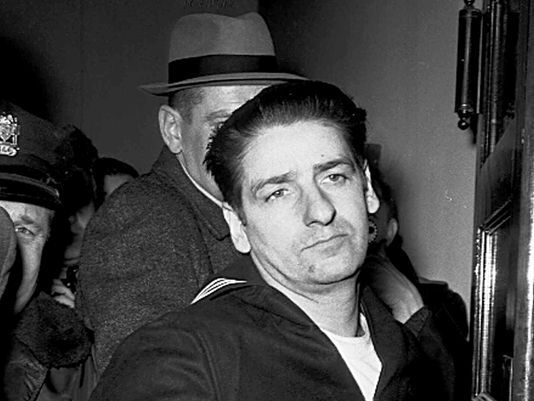 Albert DeSalvo was arrested after his escape in a military uniform he stole
Albert DeSalvo was arrested after his escape in a military uniform he stole  Walpol Prison Albert DeSalvo was a psychopath who had a plethora of enemies. He complained that he had nightmares of his wife blaming him for his behavior. (Who did he think was to blame?) He thought it was funny that he made jewelry for women in prison, specializing in “chokers.” It was one of a variety of reasons people wanted him dead. F. Lee Bailey shared that Albert was ultimately killed because of drug sales in the prison. Bailey stated, “DeSalvo was selling speed below the syndicate rate in prison and had been warned several times that if he continued they’d kill him. But Albert didn’t listen to anyone.” During his incarceration, Albert had contacted a new attorney, and told this attorney he was going to tell him the truth about the Boston Strangler Murders. Albert was killed the next morning before the attorney arrived. This has led to many theories about Albert’s innocence.
Walpol Prison Albert DeSalvo was a psychopath who had a plethora of enemies. He complained that he had nightmares of his wife blaming him for his behavior. (Who did he think was to blame?) He thought it was funny that he made jewelry for women in prison, specializing in “chokers.” It was one of a variety of reasons people wanted him dead. F. Lee Bailey shared that Albert was ultimately killed because of drug sales in the prison. Bailey stated, “DeSalvo was selling speed below the syndicate rate in prison and had been warned several times that if he continued they’d kill him. But Albert didn’t listen to anyone.” During his incarceration, Albert had contacted a new attorney, and told this attorney he was going to tell him the truth about the Boston Strangler Murders. Albert was killed the next morning before the attorney arrived. This has led to many theories about Albert’s innocence.I believe Albert DeSalvo was the Boston Strangler. I don’t believe Albert was innocent or was about to proclaim his innocence. I think Albert was upset that there were still people who didn’t believe he was the killer. DeSalvo wanted notoriety. I think DeSolvo had additional information that he felt would prove he was the Boston Strangler beyond a reasonable doubt. While Desalvo admitted to others he was the killer, he always denied this to his family. 2 days before his murder, he wrote, “To reveal his secret will bring him fame, but burden his family with unwanted shame.”
Mary Sullivan’s nephew wrote a book explaining why he believed Albert DeSalvo had not killed his 19 year old aunt. Instead, he felt the Boston Stranblings were lumped in with his other crimes to get the case resolved. A new set of investigators also began to question this, so they agreed to exhume her body and Albert DeSalvo’s body to test the DNA in 2013. And guess whose DNA was discovered in the rape kit? Albert DeSalvo. Now Mary Sullivan’s family, and all of the investigators who worked the case believe Albert DeSalvo was indeed the Boston Strangler.
One of the forensic mistakes made in this investigation was the belief that serial killers always stick to exactly the same pattern. It’s true for some, but not all. So the investigators initially thought they were dealing with 3 rapists, the Measuring man, the Boston Strangler and the Green Man, when they were dealing with 1. It’s significant to note as one ended, the next began, and all 3 ended completely with DeSalvo’s arrest. It’s also important to note that there were common themes with all of them. He manipulated his way into the apartments in all 3 scenarios without breaking in, and they all occurred in the same basic area in Massachusetts. None of the victims were prostitutes and many were college educated. They were initially able to prove beyond a reasonable doubt that DeSalvo was the Measuring Man and the Green Man rapist. DNA testing now proves he was also the Boston Strangler.
Quotes:
Beyond Colorado Detective Joe Kenda’s “My my my,” he has a variety of good quotes. I will start with my favorite:
“At first I thought he was the stupidest man on the planet. After speaking to him, I realized he was the stupidest guy on 3 or 4 planets.”
“These guys are morons. They couldn’t organize a trip to the bathroom.”
“It’s not illegal to be an ass. If it was, you’d have to build a fence around the state of Colorado and announce over a loudspeaker, ‘You’re all under arrest.’”
I have to share that my favorite quote from a BCA agent and good friend, Dick Polipnick. A rapist was complaining about how hot it was in the polygraph room. Dick casually told him, “Well imagine what it’s going to be like for you when you get to hell.”
Thanks for listening,
Frank Weber Brenda and I had a blast in Ely this weekend. We stayed at a beautiful log cabin hotel, the Grand Ely Lodge, which overlooks a lake and had good food. The bar was packed, although Brenda was only one of two women present. Great opportunity for single women, if you don't mind a cold ride home (lots of snowmobilers). I had the opportunity to speak to three 76 year old men who were leaving for a 170 mile snowmobile trip across lakes to Grand Rapids. They had done this for years and plan to continue to do this for years. We met a lot of wonderful people who enjoyed our time in the cold weather with us. Here are a few shots of the snow sculptures on main street.









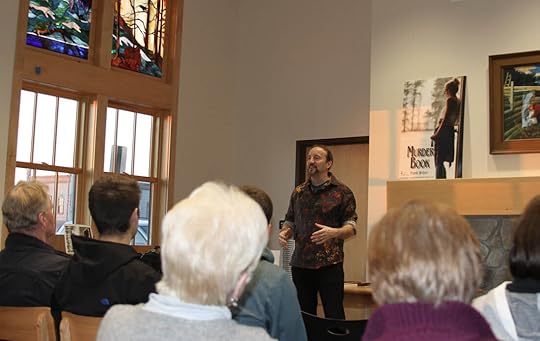
 It's been cold, but winter can be beautiful. I always enjoy that moment when the sun's setting and the snow looks blue. This winter, behind our house, we have had deer come up into our backyard from the river and a group of turkeys that run by regularly.
It's been cold, but winter can be beautiful. I always enjoy that moment when the sun's setting and the snow looks blue. This winter, behind our house, we have had deer come up into our backyard from the river and a group of turkeys that run by regularly.  The Pierz State Robotics Team: Katie Schaefer, Simon Kroll, Creo Block, Jaden Lindeman, & Michael Faust. It was fun to see the amazing work done by ingenious students. I ran into John Zenner who was there with his son, who was on the robotics team from Cold Spring.
The Pierz State Robotics Team: Katie Schaefer, Simon Kroll, Creo Block, Jaden Lindeman, & Michael Faust. It was fun to see the amazing work done by ingenious students. I ran into John Zenner who was there with his son, who was on the robotics team from Cold Spring.
Published on February 10, 2018 00:00
February 1, 2018
Fun with Numbers and a Week in the Life of the Morrison County Police
On Saturday, February 3, Frank will be speaking on Murder Book at the Shoppes of Little Falls from 10:30 to 11:30 a.m. and will be signing books after.
On Monday, February 5, Frank will be speaking on Murder Book and forensic work over the lunch from 12:00 to 1:00 at the Brainerd Public Library, where people are invited to bring their lunch or a snack while he speaks and then signs books.
On Thursday evening, February 8, from 7:00 to 9:00 p.m., Frank will kick off his events at Winterfest in Ely, by speaking to a creative writing group at Vermillion College. The following day, Friday, February 9, Frank will speak to a Criminal Justice class at Vermillion on forensic work. That evening he will speak to the Ely Public Library on Murder Book from 5:00 to 6:30 and will sign books after. Frank and Brenda plan on seeing the snow sculptures, walking the art walk, and attending “the Great Nordic Beardfest” at the Boathouse Brew Pub. Webers playing music
Webers playing music  Preston and Frank try a glass of Kilkenny at the Old Brickhouse in St. Cloud. If you’ve read Murder Book, you have an idea of how numbers play in my head. Here’s an example of a recent thought:
Preston and Frank try a glass of Kilkenny at the Old Brickhouse in St. Cloud. If you’ve read Murder Book, you have an idea of how numbers play in my head. Here’s an example of a recent thought:
Of the approximately 450 NBA players, about 330 are African American—a fraction close to three in four. But among more than 20 million African-American men in the United States, only a very small portion play in the NBA—less than 0.01 percent. In other words, we can be about 75 percent confident that an NBA player is African American. But if we know only that a man is African American, it is pretty unlikely that he is an NBA player. (About 1 in 45,000).
A recent claim that “nearly 3 in 4 individuals convicted of terrorism-related charges are foreign born” follows the same logic. Not only does this figure not include domestic terrorism, but using it also exploits a slippery psychological trick. The odds of an individual convicted of terrorism-related charges in a US federal court being foreign-born is about 75 percent. But if an individual is foreign-born, the likelihood that the person has engaged in terrorism-related activities is nearly zero. There are approximately 41 million foreign-born people living in the United States; 402 out of 41 million is a minuscule proportion—less than 0.001 percent. The odds of a foreign-born person being a terrorist in the United States is 1 in every 102,000 foreign born Americans.
To put this in perspective, it is 3x more likely that your next door neighbor was an active player in the National Football League this past season than a foreign-born person is a terrorist in the United States. In other words, if you and everyone you know was living next to foreign born individuals, the odds are none of you would be living next to a terrorist. Seriously consider-- are you or is anybody you know living directly next to a 2017 NFL player (not a relative or family member, the actual player). Living next to an NFL player is 3x more likely than living next to a terrorist, if you and everyone you know lived next to foreign-born citizens.
My brother saved this police report and shared it with me. Here is an honest example of the weird weeks police in our area have. It’s significant to note that this isn’t an abbreviated report. This was every crime listed that week. Nothing was omitted. This is the police blotter for Morrison County for the week of 10/11/15, taken from the Morrison County Record.
Lawn mower calls police over breaking his own windows. At 1:16 p.m. Friday, Oct. 16, in Swanville, a complainant reported he parked his vehicle on the street to mow the lawn and noticed someone broke out his back window while it was parked there. Deputy arrived, looked at the scene and noticed the lawn was freshly mowed. Deputy also noticed it was mowed very short with loose rocks all over. Looking at the vehicle and the scene, it does appear that the mowing caused rocks to hit and break two windows in the vehicle. Deputy did find one rock that had marks on it from the mower hitting it and was laying by the parked vehicle. The two windows that were broken were the back and the side window, which were facing where he was mowing the yard.
“Somebody hit my mailbox with a pumpkin.” At 12:07 p.m. Monday in Bowlus, a woman reported her mailbox had been hit with a pumpkin. The deputy told the woman there was a string of similar incidents in the area. The deputy told her he would let her know if the office found out who did it.
Horse running at large. At 7:44 p.m. Wednesday in Hillman, a complainant reported a horse was running at large on the road. Upon the deputy's arrival, a man called and said it was his horse and he put it away.
Deer in truck, waiting for chores to get done. At 2:18 p.m. Wednesday in Royalton, a man reported he hit a deer very early in the morning while en route to milk cows. He put the deer in the back of the truck until he was done with the chores. He requested a permit for the deer. Deputy wrote a permit for him and the man stopped by the sheriff's office and picked the permit up.
Car door locked in a field. At 1:47 p.m. Wednesday in Little Falls, a woman called to ask if a deputy could come open her car door. She was in a field off of 160th Avenue in Little Falls Township. The deputy responded to the location and opened the car door.
Cat attacker sent to Hillbilly Haven. At 1:45 a.m. Tuesday in Pierz, Deputy spoke with a man, who said his daughter's cat got hurt and she blamed the father for doing it. The man said when his daughter accused him of hurting the cat, and he yelled at her. The man said his daughter pushed him and told him to leave. The daughter confirmed the story. The boyfriend said he would pay for a room for the father for the night at the Hillbilly Haven in Pierz. The father was transported there and no one was charged for assault.
Tailgate stolen off truck. At 9:34 a.m. Saturday, Oct. 17, on the 200 block of Main Street in Upsala, a complainant reported the tailgate had been stolen from their pickup truck.
People practice shooting at exploding target. At 6:44 p.m. Saturday, Oct. 17, in Pierz, a complainant reported there were people shooting guns in a field across from their residence all day and they just recently shot something that exploded. The deputy responded and met with the subjects in the field. Both subjects said they were shooting and just shot tannerite. Both subjects said they were done shooting for the day and about to go home. The deputy left the field and notified the complainant of the findings.
Woman asked to just go away. Report at 7:30 p.m. Wednesday of a verbal dispute on the 1000 block of Oak Street. The subject was gone on officer arrival. The caller asked officers to tell the woman not to come back.
Kids taught to act properly. Report at 6:55 p.m. Wednesday of kids being disruptive with their parents at an address on Quince Street. An officer advised the kids "how to act properly," according to the report.
Dog howling. At 10:42 a.m. Thursday on the 11000 block of River Vista Drive, a complainant reported their neighbor's dog has been howling for the past three days. Officer made contact with the dog's owners and advised them of the complaint.
Quote for the week:
My favorite quote for the week comes from a pre-school girl (related to one of our CORE staff) making her first dentist visit. The dentist asked, “If I open your mouth, am I going to find money?”
The girl’s response was, “No. But if you open my heart you will find Jesus, and if you open my pants you will find Barney the purple dinosaur underwear.” (Still working on discretion.)
Thanks for listening,
Frank
“Mary Don’t You Weep” is a spiritual song that had its origin before the civil war. It contains coded messages offering hope to slaves. It became popular again during the Civil Rights Movement. I’ve always like this song.






































On Monday, February 5, Frank will be speaking on Murder Book and forensic work over the lunch from 12:00 to 1:00 at the Brainerd Public Library, where people are invited to bring their lunch or a snack while he speaks and then signs books.
On Thursday evening, February 8, from 7:00 to 9:00 p.m., Frank will kick off his events at Winterfest in Ely, by speaking to a creative writing group at Vermillion College. The following day, Friday, February 9, Frank will speak to a Criminal Justice class at Vermillion on forensic work. That evening he will speak to the Ely Public Library on Murder Book from 5:00 to 6:30 and will sign books after. Frank and Brenda plan on seeing the snow sculptures, walking the art walk, and attending “the Great Nordic Beardfest” at the Boathouse Brew Pub.
 Webers playing music
Webers playing music  Preston and Frank try a glass of Kilkenny at the Old Brickhouse in St. Cloud. If you’ve read Murder Book, you have an idea of how numbers play in my head. Here’s an example of a recent thought:
Preston and Frank try a glass of Kilkenny at the Old Brickhouse in St. Cloud. If you’ve read Murder Book, you have an idea of how numbers play in my head. Here’s an example of a recent thought:Of the approximately 450 NBA players, about 330 are African American—a fraction close to three in four. But among more than 20 million African-American men in the United States, only a very small portion play in the NBA—less than 0.01 percent. In other words, we can be about 75 percent confident that an NBA player is African American. But if we know only that a man is African American, it is pretty unlikely that he is an NBA player. (About 1 in 45,000).
A recent claim that “nearly 3 in 4 individuals convicted of terrorism-related charges are foreign born” follows the same logic. Not only does this figure not include domestic terrorism, but using it also exploits a slippery psychological trick. The odds of an individual convicted of terrorism-related charges in a US federal court being foreign-born is about 75 percent. But if an individual is foreign-born, the likelihood that the person has engaged in terrorism-related activities is nearly zero. There are approximately 41 million foreign-born people living in the United States; 402 out of 41 million is a minuscule proportion—less than 0.001 percent. The odds of a foreign-born person being a terrorist in the United States is 1 in every 102,000 foreign born Americans.
To put this in perspective, it is 3x more likely that your next door neighbor was an active player in the National Football League this past season than a foreign-born person is a terrorist in the United States. In other words, if you and everyone you know was living next to foreign born individuals, the odds are none of you would be living next to a terrorist. Seriously consider-- are you or is anybody you know living directly next to a 2017 NFL player (not a relative or family member, the actual player). Living next to an NFL player is 3x more likely than living next to a terrorist, if you and everyone you know lived next to foreign-born citizens.
My brother saved this police report and shared it with me. Here is an honest example of the weird weeks police in our area have. It’s significant to note that this isn’t an abbreviated report. This was every crime listed that week. Nothing was omitted. This is the police blotter for Morrison County for the week of 10/11/15, taken from the Morrison County Record.
Lawn mower calls police over breaking his own windows. At 1:16 p.m. Friday, Oct. 16, in Swanville, a complainant reported he parked his vehicle on the street to mow the lawn and noticed someone broke out his back window while it was parked there. Deputy arrived, looked at the scene and noticed the lawn was freshly mowed. Deputy also noticed it was mowed very short with loose rocks all over. Looking at the vehicle and the scene, it does appear that the mowing caused rocks to hit and break two windows in the vehicle. Deputy did find one rock that had marks on it from the mower hitting it and was laying by the parked vehicle. The two windows that were broken were the back and the side window, which were facing where he was mowing the yard.
“Somebody hit my mailbox with a pumpkin.” At 12:07 p.m. Monday in Bowlus, a woman reported her mailbox had been hit with a pumpkin. The deputy told the woman there was a string of similar incidents in the area. The deputy told her he would let her know if the office found out who did it.
Horse running at large. At 7:44 p.m. Wednesday in Hillman, a complainant reported a horse was running at large on the road. Upon the deputy's arrival, a man called and said it was his horse and he put it away.
Deer in truck, waiting for chores to get done. At 2:18 p.m. Wednesday in Royalton, a man reported he hit a deer very early in the morning while en route to milk cows. He put the deer in the back of the truck until he was done with the chores. He requested a permit for the deer. Deputy wrote a permit for him and the man stopped by the sheriff's office and picked the permit up.
Car door locked in a field. At 1:47 p.m. Wednesday in Little Falls, a woman called to ask if a deputy could come open her car door. She was in a field off of 160th Avenue in Little Falls Township. The deputy responded to the location and opened the car door.
Cat attacker sent to Hillbilly Haven. At 1:45 a.m. Tuesday in Pierz, Deputy spoke with a man, who said his daughter's cat got hurt and she blamed the father for doing it. The man said when his daughter accused him of hurting the cat, and he yelled at her. The man said his daughter pushed him and told him to leave. The daughter confirmed the story. The boyfriend said he would pay for a room for the father for the night at the Hillbilly Haven in Pierz. The father was transported there and no one was charged for assault.
Tailgate stolen off truck. At 9:34 a.m. Saturday, Oct. 17, on the 200 block of Main Street in Upsala, a complainant reported the tailgate had been stolen from their pickup truck.
People practice shooting at exploding target. At 6:44 p.m. Saturday, Oct. 17, in Pierz, a complainant reported there were people shooting guns in a field across from their residence all day and they just recently shot something that exploded. The deputy responded and met with the subjects in the field. Both subjects said they were shooting and just shot tannerite. Both subjects said they were done shooting for the day and about to go home. The deputy left the field and notified the complainant of the findings.
Woman asked to just go away. Report at 7:30 p.m. Wednesday of a verbal dispute on the 1000 block of Oak Street. The subject was gone on officer arrival. The caller asked officers to tell the woman not to come back.
Kids taught to act properly. Report at 6:55 p.m. Wednesday of kids being disruptive with their parents at an address on Quince Street. An officer advised the kids "how to act properly," according to the report.
Dog howling. At 10:42 a.m. Thursday on the 11000 block of River Vista Drive, a complainant reported their neighbor's dog has been howling for the past three days. Officer made contact with the dog's owners and advised them of the complaint.
Quote for the week:
My favorite quote for the week comes from a pre-school girl (related to one of our CORE staff) making her first dentist visit. The dentist asked, “If I open your mouth, am I going to find money?”
The girl’s response was, “No. But if you open my heart you will find Jesus, and if you open my pants you will find Barney the purple dinosaur underwear.” (Still working on discretion.)
Thanks for listening,
Frank
“Mary Don’t You Weep” is a spiritual song that had its origin before the civil war. It contains coded messages offering hope to slaves. It became popular again during the Civil Rights Movement. I’ve always like this song.







































Published on February 01, 2018 06:03
January 24, 2018
Billionaires and Babies
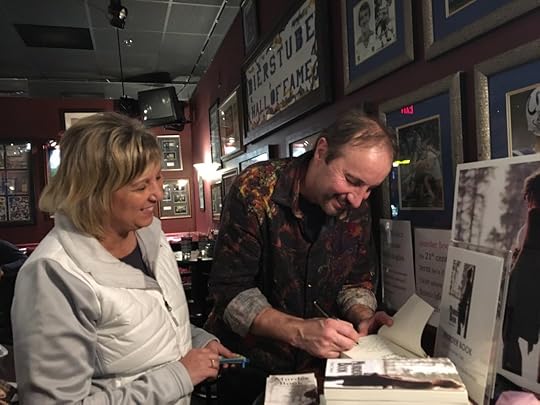 Frank signing books at the Bierstube to a packed crowd in Hastings last Thursday
Frank signing books at the Bierstube to a packed crowd in Hastings last Thursday February 3, 2018 Presentation on Murder Book and Forensic Psychology. The Shoppes of Little Falls . 10:30 to 11:30 am
February 5, 2018 Presentation on Murder Book and the writing process. Brainerd Public Library. It’s a “brown bag” event where people are welcome to bring their lunch and enjoy it during the presentation. Frank will sign and sell books at the event. 12:00 to 1:00 pm The Vikings and the Twins both made the playoffs this past season, which is an improvement of the disastrous previous years. The Vikings gave us “the play” we were all able to celebrate and I’m grateful for that. Plus, I really felt they played like a team more than previous years, which made them more entertaining. Prior to the Minnesota Miracle, as the press dubbed it, being a Vikings fan was like being married to Kardashian—you had the sense that it was going to ruin your life. (Lamar Odom went from being a millionaire to a homeless addict, Bruce Jenner changed his sex, and Kris Humphries managed to escape after a couple weeks of marriage…) Kris Humphries' grandmother lives in St. Cloud and Kris came through with an autographed jersey and an autographed basketball for Matt Athman’s fundraiser. Thank you Kris!
2017 Was Really Good for Billionaires:
We have the potential to live better than ever, but in a democracy, we always need to be watchful of greed. Here are some interesting financial statistics from last year. 82% of all of the new wealth created in 2017 went to the top 1%. The bottom 50% received no change in income. The world is producing new billionaires at an unprecedented pace, with an average of one more being added every other day, a new Oxfam report finds.
There are now 2,043 billionaires worldwide. "Nine out of 10 are men,” Oxfam says in its “Reward Work, Not Wealth” report. “In 12 months, the wealth of this elite group has increased by $762 billion. This is enough to end extreme poverty seven times over."
“In the period between 2006 and 2015, ordinary workers saw their incomes rise by an average of just 2% a year, while billionaire wealth rose by nearly 13% a year – more than six times faster.”
“Approximately a third of billionaire wealth is derived from inheritance. Over the next 20 years, 500 of the world’s richest people will hand over $2.4 trillion to their heirs – a sum larger than the Gross Domestic Product of India, a country of 1.3 billion people.” The wealth of 500 people is greater than that of the total monetary value of all of the goods and services of world’s 2nd largest country of 1.3 billion people. (There are 7.4 billion people on earth.) At some point we need a leader who is willing to address inequality. We live well, but everyone could live better.
A number of wonderful people I know have recently had a baby, or are going to have a baby. Today, in 1985, our daughter Nicolette was born. I was present for the births of Nicolette, Shane and Preston. It’s a helpless feeling, as a father, watching a woman I love and would give my life for, in so much pain, with so much at stake, while I stand there and suggest she breathe differently. It would seem reasonable that she’d strike me with something, but she didn’t. We were offered a room ‘just like a living room’ to have our baby in. I told them I didn’t want to have a baby in my living room. I wanted to have a baby in a room with medical machines that have wavy lines and blinking lights, so if something goes wrong the equipment is right there. Less than a century ago, giving birth was one of the leading causes of death for women because we didn’t have this technology.
Babies are miracles. It’s crazy when I consider that a completely new person came out of my wife’s body. It’s sort of like a Sci-Fi movie. It’s wonderful and beautiful, but nothing I’d ever want to film, or even watch again, but I wouldn’t miss it. Despite all the pain, and the fact that another human being had just exited her body, Brenda looked so perfect as she held our children immediately after. I had a better understanding of birth after the first time. No matter what anybody tells you, you’re not prepared for seeing your child born. I remember asking a classmate in high school who had fathered a baby, ‘Who does the baby look like?’ He responded, ‘It doesn’t look like me or her. It looks like an Indian.’ I was better informed, but still surprised. After Nicolette was born there was blood all over. For Brenda’s sake I tried to look calm and undisturbed as I thought, “Holy crap, no wonder people died.” This didn’t happen when Shane was born, so I asked about it and found out Brenda had hemorrhaged when Nicolette was born. No one had informed me that this wasn’t normal. I am thankful for mothers who take care of their babies during their pregnancy and after. Being a parent is the most exhausting and rewarding event I’ve experienced. When Nicolette was born, I taught at a Catholic school in St. Cloud which didn’t offer medical insurance. Nicolette’s stomach wasn’t fully developed and required a special formula which put us thousands of dollars in debt. But Nicolette put it all in perspective for me. When she’d wake up, she just wanted to play. It didn’t make any difference to her if I was a billionaire or a billion dollars in debt. So I had to focus on enjoying those moments, and pray it would work out… and it did.
Quotes:
During an anti-harassment seminar at work, a person asked, "What’s the difference between harassment and good-natured teasing?" A co-worker shouted, "A million dollars."
Wife: I think you only married me because my dad left me a lot of money.
Husband: That's not true. I don't care who left you the money.
“That would be a good thing for them to put on my tombstone: Wherever she went, including here, it was against her better judgment.” -Dorothy Parker
 I believe it was Dorothy Parker who once said, “If you took all the women who went to prom at Yale, and laid them end to end, I wouldn’t be surprised.”
I believe it was Dorothy Parker who once said, “If you took all the women who went to prom at Yale, and laid them end to end, I wouldn’t be surprised.”Thanks for listening,
Frank 1994
 Preston
Preston 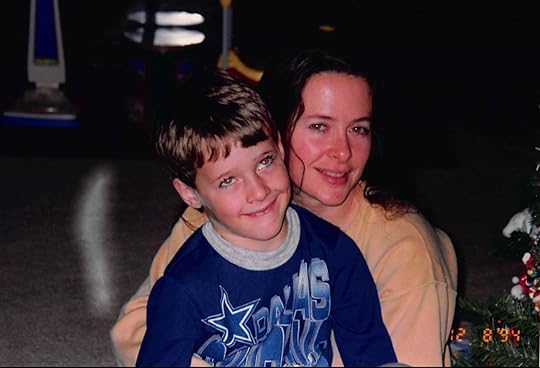 Shane and Brenda
Shane and Brenda  Nicolette and Shane
Nicolette and Shane  Allison Kloss, Nicolette (Weber) Deal and Carli Wulff Maher
Allison Kloss, Nicolette (Weber) Deal and Carli Wulff Maher  Frank, Preston and Nicolette
Frank, Preston and Nicolette  Preston, Frank, Nicolette, Brenda, and Shane Weber
Preston, Frank, Nicolette, Brenda, and Shane Weber  Preston, Brenda, Shane, and Nicolette
Preston, Brenda, Shane, and Nicolette  Frank and Preston
Frank and Preston  Shane
Shane  Brenda
Brenda  Brenda, Nicolette, Shane, Preston, and Frank
Brenda, Nicolette, Shane, Preston, and Frank  Elizabeth Weber as Grand Marshall of the 1994 Octoberfest in Pierz
Elizabeth Weber as Grand Marshall of the 1994 Octoberfest in Pierz 
















Published on January 24, 2018 09:22
January 15, 2018
Redemption, The Kids Are Alright, the Bierstube
Options for the back cover of I-94 Murders. 
 Frank will be speaking on Murder Book at The Bierstube in Hastings on Thursday at 6:30 pm.January 18, 2018 Discussing Murder Book at
Bookstube at the Bierstube
. 109 11th Street West, Hastings, Minnesota. 6:30 to 8:30 pmFebruary 5, 2018 Presentation on Murder Book and the writing process.
Brainerd Public Library
. It’s a “brown bag” event where people are welcome to bring their lunch and enjoy it during the presentation. Frank will sign and sell books at the event. 12:00 to 1:00 pmFebruary 5, 2018 Frank will provide training on Addressing Sexual Trauma to staff at Hands of Hope Victim Resource Center in Little Falls, Minnesota. 5:00 pm What an amazing finish to the Vikings game! My brother John was with Joe and grandson Dominic at the game and indicated everybody was hugging and high fiving after. A sports announcer later said, but it doesn’t mean anything if the Vikings don’t win next week. That is not true, and Vikings fans know exactly what I mean. That was a moment of redemption. I drove Brenda to the airport so she could spend a week in Maryland with Branden, Nicolette and our granddaughter, Kaycee Deal. The roads were terrible all the way to the airport and all the way back, but I was in a great mood. I just wanted to hear about that play, and later watch it, over and over. Even though my kids are in 3 different states, they all watched it, celebrated it and called and laughed about it. As I tell people, “the good guys win just often enough.” Sunday night we won, and we will always have that moment. Thank you Vikings for giving it your best to the very last moment! It’s all we can ask.
Frank will be speaking on Murder Book at The Bierstube in Hastings on Thursday at 6:30 pm.January 18, 2018 Discussing Murder Book at
Bookstube at the Bierstube
. 109 11th Street West, Hastings, Minnesota. 6:30 to 8:30 pmFebruary 5, 2018 Presentation on Murder Book and the writing process.
Brainerd Public Library
. It’s a “brown bag” event where people are welcome to bring their lunch and enjoy it during the presentation. Frank will sign and sell books at the event. 12:00 to 1:00 pmFebruary 5, 2018 Frank will provide training on Addressing Sexual Trauma to staff at Hands of Hope Victim Resource Center in Little Falls, Minnesota. 5:00 pm What an amazing finish to the Vikings game! My brother John was with Joe and grandson Dominic at the game and indicated everybody was hugging and high fiving after. A sports announcer later said, but it doesn’t mean anything if the Vikings don’t win next week. That is not true, and Vikings fans know exactly what I mean. That was a moment of redemption. I drove Brenda to the airport so she could spend a week in Maryland with Branden, Nicolette and our granddaughter, Kaycee Deal. The roads were terrible all the way to the airport and all the way back, but I was in a great mood. I just wanted to hear about that play, and later watch it, over and over. Even though my kids are in 3 different states, they all watched it, celebrated it and called and laughed about it. As I tell people, “the good guys win just often enough.” Sunday night we won, and we will always have that moment. Thank you Vikings for giving it your best to the very last moment! It’s all we can ask.
I think it’s funny how our media pays little attention to some of the good news around us, unless they can put a frightening spin on it. Here is some new data from a respected magazine called The Economist.
-Teenagers are getting drunk less often.
-They start drinking later: the average age at which young individuals first try alcohol has risen from 14.4 to 16.1 since 1998. And even when they start, they sip rather than chug. In Britain, a fifth of 16 to 24-year-olds do not drink at all. In the past, young people went out for a drink and perhaps had something to eat at the same time, says Kate Nicholls, head of the Association of Licensed Multiple Retailers, a trade group. Now it is the other way round.
-“Teenagers are also having less sex, especially of the procreative kind.”
1991
54% of American teenagers in grades nine to twelve (ages 14-18) reported that they were sexually experienced. 19% claimed to have had sex with at least four partners.
2015
41% of American teenagers in grades nine to twelve (ages 14-18) reported that they were sexually experienced, and 12% claimed to have had sex with at least four partners.
In short, young people are less hedonistic and break fewer rules than in the past.
Quotes:
I was looking for some humorous quotes from Mark Twain and instead found numerous writers who analyzed his humor. They must have missed Twain’s message when he said, “Explaining humor is a lot like dissecting a frog, you learn a lot in the process, but in the end you kill it.” -Mark Twain
“I’ve been told to speed up my delivery when I perform. But if I lose the stammer, I’m just another slightly amusing accountant.” -Bob Newhart
My mom looks at my dad and goes, 'Do I look fat in this dress?' And my dad goes, 'Don't be stupid, you look fat in everything.' -Carlos Mencia
I love America. It’s a great country of great opportunity. If I wouldn’t have come to America I’d be the funniest guy milking a cow in Honduras. –Carlos Mencia
Thanks for listening,
Frank This may be my favorite hit song with horns. This was an incredibly talented band, even though they dressed a little like very shiny Games of Thrones characters. With that talent, they can dress however they wish. Kelsey Stuckmayer scores 1000th point
Kelsey Stuckmayer scores 1000th point  Brittney Boser
Brittney Boser  Avy Lease
Avy Lease  Kelsi Stuckmayer
Kelsi Stuckmayer  Laura Skiba
Laura Skiba  Laura Skiba
Laura Skiba  Avy Lease, Kelsi Stuckmayer
Avy Lease, Kelsi Stuckmayer  Alyssa Sadlosky, Alana Rocheleau, Kylie Porter, Jordyn Jansen
Alyssa Sadlosky, Alana Rocheleau, Kylie Porter, Jordyn Jansen  Avy Lease
Avy Lease  Rabeka Langer
Rabeka Langer  Rabeka Langer
Rabeka Langer  Malea Boser drives to the hoop for 2
Malea Boser drives to the hoop for 2  Taylor Kimman
Taylor Kimman  Kelsi Stuckmayer, Taylor Kimman
Kelsi Stuckmayer, Taylor Kimman  Jake Andres records 100th win
Jake Andres records 100th win  Sebastian Warzecha
Sebastian Warzecha  Austin Radunz
Austin Radunz  Brandon Tomala
Brandon Tomala  Alex Barclay
Alex Barclay  Reese Kapsner records 100th win
Reese Kapsner records 100th win  Reese Kapsner
Reese Kapsner  Reese Kapsner “Take that fool!”
Reese Kapsner “Take that fool!”  Carson Huls
Carson Huls  Luke Girtz
Luke Girtz  Austin Dickmann
Austin Dickmann  Brandon Funk
Brandon Funk  Jake Andres
Jake Andres  Jake Andres
Jake Andres  Frank Tomberlin
Frank Tomberlin  Riley Hoskins
Riley Hoskins  Alex Barclay
Alex Barclay  Carson Huls
Carson Huls  Carson Huls
Carson Huls  Carson Huls pins opponent
Carson Huls pins opponent  Jacob Gotvald
Jacob Gotvald  Jacob Gotvald
Jacob Gotvald  Trevor Radunz
Trevor Radunz  Ross Boser
Ross Boser  Jake Andres
Jake Andres  Brandon Tomala
Brandon Tomala  Jalen Jansen
Jalen Jansen  Luke Girtz
Luke Girtz  Luke Girtz
Luke Girtz  Jonah Prokott
Jonah Prokott  Robbie Schaefer
Robbie Schaefer  Brandon Stuckmayer
Brandon Stuckmayer  Pierz JV Pizazz
Pierz JV Pizazz  Pierz JV Pizazz
Pierz JV Pizazz  Madison Tahlberg
Madison Tahlberg  Summer Woitalla and Morgan Pohlkamp
Summer Woitalla and Morgan Pohlkamp  Cody Kimman
Cody Kimman  Michael Leidenfrost
Michael Leidenfrost  Mason Zajac scoops up loose ball and dishes it to teammate for an easy 2
Mason Zajac scoops up loose ball and dishes it to teammate for an easy 2  Brent Schilling
Brent Schilling  Alex Wilson
Alex Wilson  Mason Zajac
Mason Zajac  Charles Pekar
Charles Pekar  Robbie Schaefer
Robbie Schaefer  Jacob Fuhrman
Jacob Fuhrman  Kylie Porter, Haley Koch, Amaya Rocheleau, Leah Scholl, Winn Stamm
Kylie Porter, Haley Koch, Amaya Rocheleau, Leah Scholl, Winn Stamm  Pierz Pep Band
Pierz Pep Band  Pierz Pep Band
Pierz Pep Band  Pierz Pep Band
Pierz Pep Band

 Frank will be speaking on Murder Book at The Bierstube in Hastings on Thursday at 6:30 pm.January 18, 2018 Discussing Murder Book at
Bookstube at the Bierstube
. 109 11th Street West, Hastings, Minnesota. 6:30 to 8:30 pmFebruary 5, 2018 Presentation on Murder Book and the writing process.
Brainerd Public Library
. It’s a “brown bag” event where people are welcome to bring their lunch and enjoy it during the presentation. Frank will sign and sell books at the event. 12:00 to 1:00 pmFebruary 5, 2018 Frank will provide training on Addressing Sexual Trauma to staff at Hands of Hope Victim Resource Center in Little Falls, Minnesota. 5:00 pm What an amazing finish to the Vikings game! My brother John was with Joe and grandson Dominic at the game and indicated everybody was hugging and high fiving after. A sports announcer later said, but it doesn’t mean anything if the Vikings don’t win next week. That is not true, and Vikings fans know exactly what I mean. That was a moment of redemption. I drove Brenda to the airport so she could spend a week in Maryland with Branden, Nicolette and our granddaughter, Kaycee Deal. The roads were terrible all the way to the airport and all the way back, but I was in a great mood. I just wanted to hear about that play, and later watch it, over and over. Even though my kids are in 3 different states, they all watched it, celebrated it and called and laughed about it. As I tell people, “the good guys win just often enough.” Sunday night we won, and we will always have that moment. Thank you Vikings for giving it your best to the very last moment! It’s all we can ask.
Frank will be speaking on Murder Book at The Bierstube in Hastings on Thursday at 6:30 pm.January 18, 2018 Discussing Murder Book at
Bookstube at the Bierstube
. 109 11th Street West, Hastings, Minnesota. 6:30 to 8:30 pmFebruary 5, 2018 Presentation on Murder Book and the writing process.
Brainerd Public Library
. It’s a “brown bag” event where people are welcome to bring their lunch and enjoy it during the presentation. Frank will sign and sell books at the event. 12:00 to 1:00 pmFebruary 5, 2018 Frank will provide training on Addressing Sexual Trauma to staff at Hands of Hope Victim Resource Center in Little Falls, Minnesota. 5:00 pm What an amazing finish to the Vikings game! My brother John was with Joe and grandson Dominic at the game and indicated everybody was hugging and high fiving after. A sports announcer later said, but it doesn’t mean anything if the Vikings don’t win next week. That is not true, and Vikings fans know exactly what I mean. That was a moment of redemption. I drove Brenda to the airport so she could spend a week in Maryland with Branden, Nicolette and our granddaughter, Kaycee Deal. The roads were terrible all the way to the airport and all the way back, but I was in a great mood. I just wanted to hear about that play, and later watch it, over and over. Even though my kids are in 3 different states, they all watched it, celebrated it and called and laughed about it. As I tell people, “the good guys win just often enough.” Sunday night we won, and we will always have that moment. Thank you Vikings for giving it your best to the very last moment! It’s all we can ask.I think it’s funny how our media pays little attention to some of the good news around us, unless they can put a frightening spin on it. Here is some new data from a respected magazine called The Economist.
-Teenagers are getting drunk less often.
-They start drinking later: the average age at which young individuals first try alcohol has risen from 14.4 to 16.1 since 1998. And even when they start, they sip rather than chug. In Britain, a fifth of 16 to 24-year-olds do not drink at all. In the past, young people went out for a drink and perhaps had something to eat at the same time, says Kate Nicholls, head of the Association of Licensed Multiple Retailers, a trade group. Now it is the other way round.
-“Teenagers are also having less sex, especially of the procreative kind.”
1991
54% of American teenagers in grades nine to twelve (ages 14-18) reported that they were sexually experienced. 19% claimed to have had sex with at least four partners.
2015
41% of American teenagers in grades nine to twelve (ages 14-18) reported that they were sexually experienced, and 12% claimed to have had sex with at least four partners.
In short, young people are less hedonistic and break fewer rules than in the past.
Quotes:
I was looking for some humorous quotes from Mark Twain and instead found numerous writers who analyzed his humor. They must have missed Twain’s message when he said, “Explaining humor is a lot like dissecting a frog, you learn a lot in the process, but in the end you kill it.” -Mark Twain
“I’ve been told to speed up my delivery when I perform. But if I lose the stammer, I’m just another slightly amusing accountant.” -Bob Newhart
My mom looks at my dad and goes, 'Do I look fat in this dress?' And my dad goes, 'Don't be stupid, you look fat in everything.' -Carlos Mencia
I love America. It’s a great country of great opportunity. If I wouldn’t have come to America I’d be the funniest guy milking a cow in Honduras. –Carlos Mencia
Thanks for listening,
Frank This may be my favorite hit song with horns. This was an incredibly talented band, even though they dressed a little like very shiny Games of Thrones characters. With that talent, they can dress however they wish.
 Kelsey Stuckmayer scores 1000th point
Kelsey Stuckmayer scores 1000th point  Brittney Boser
Brittney Boser  Avy Lease
Avy Lease  Kelsi Stuckmayer
Kelsi Stuckmayer  Laura Skiba
Laura Skiba  Laura Skiba
Laura Skiba  Avy Lease, Kelsi Stuckmayer
Avy Lease, Kelsi Stuckmayer  Alyssa Sadlosky, Alana Rocheleau, Kylie Porter, Jordyn Jansen
Alyssa Sadlosky, Alana Rocheleau, Kylie Porter, Jordyn Jansen  Avy Lease
Avy Lease  Rabeka Langer
Rabeka Langer  Rabeka Langer
Rabeka Langer  Malea Boser drives to the hoop for 2
Malea Boser drives to the hoop for 2  Taylor Kimman
Taylor Kimman  Kelsi Stuckmayer, Taylor Kimman
Kelsi Stuckmayer, Taylor Kimman  Jake Andres records 100th win
Jake Andres records 100th win  Sebastian Warzecha
Sebastian Warzecha  Austin Radunz
Austin Radunz  Brandon Tomala
Brandon Tomala  Alex Barclay
Alex Barclay  Reese Kapsner records 100th win
Reese Kapsner records 100th win  Reese Kapsner
Reese Kapsner  Reese Kapsner “Take that fool!”
Reese Kapsner “Take that fool!”  Carson Huls
Carson Huls  Luke Girtz
Luke Girtz  Austin Dickmann
Austin Dickmann  Brandon Funk
Brandon Funk  Jake Andres
Jake Andres  Jake Andres
Jake Andres  Frank Tomberlin
Frank Tomberlin  Riley Hoskins
Riley Hoskins  Alex Barclay
Alex Barclay  Carson Huls
Carson Huls  Carson Huls
Carson Huls  Carson Huls pins opponent
Carson Huls pins opponent  Jacob Gotvald
Jacob Gotvald  Jacob Gotvald
Jacob Gotvald  Trevor Radunz
Trevor Radunz  Ross Boser
Ross Boser  Jake Andres
Jake Andres  Brandon Tomala
Brandon Tomala  Jalen Jansen
Jalen Jansen  Luke Girtz
Luke Girtz  Luke Girtz
Luke Girtz  Jonah Prokott
Jonah Prokott  Robbie Schaefer
Robbie Schaefer  Brandon Stuckmayer
Brandon Stuckmayer  Pierz JV Pizazz
Pierz JV Pizazz  Pierz JV Pizazz
Pierz JV Pizazz  Madison Tahlberg
Madison Tahlberg  Summer Woitalla and Morgan Pohlkamp
Summer Woitalla and Morgan Pohlkamp  Cody Kimman
Cody Kimman  Michael Leidenfrost
Michael Leidenfrost  Mason Zajac scoops up loose ball and dishes it to teammate for an easy 2
Mason Zajac scoops up loose ball and dishes it to teammate for an easy 2  Brent Schilling
Brent Schilling  Alex Wilson
Alex Wilson  Mason Zajac
Mason Zajac  Charles Pekar
Charles Pekar  Robbie Schaefer
Robbie Schaefer  Jacob Fuhrman
Jacob Fuhrman  Kylie Porter, Haley Koch, Amaya Rocheleau, Leah Scholl, Winn Stamm
Kylie Porter, Haley Koch, Amaya Rocheleau, Leah Scholl, Winn Stamm  Pierz Pep Band
Pierz Pep Band  Pierz Pep Band
Pierz Pep Band  Pierz Pep Band
Pierz Pep Band
Published on January 15, 2018 06:00
January 6, 2018
Serial killers, Cereal Healers and “Who needs a house out in Pakistan?”
Join me this Tuesday, January 9, at Monticello Public Library. I'll be speaking on Murder Book and forensic psychology from 6:30 to 7:30 pm. 

 The sequel to Murder Book, I-94 Murders, is now finished and at North Star Press. Alicia Isom is the model featured on the cover. I appreciate the suggestions for other titles and covers I’ve received and I’m still mulling them over. We are also still considering book covers. It’s interesting how movies and TV shows emphasize over and over again how serial killers are predominantly white. They are in all the shows, right? It’s actually not true. About 31% of serial killers in the United States are of now of European Ancestry (formerly known as white). About 60% are African American, 8% are Chicano (Hispanic) and 1% are Asian. This suggests to me we have a significant poverty issue in our inner cities that needs to be addressed. I fear sometimes we are missing the seriousness of the problem by ignoring data we have. As a forensic psychologist I believe very strongly in the importance of evidence. It’s very difficult to resolve a problem without understanding the specifics of the problem. The evidence would suggest we have parts of the U.S. that are crazy dangerous.
The sequel to Murder Book, I-94 Murders, is now finished and at North Star Press. Alicia Isom is the model featured on the cover. I appreciate the suggestions for other titles and covers I’ve received and I’m still mulling them over. We are also still considering book covers. It’s interesting how movies and TV shows emphasize over and over again how serial killers are predominantly white. They are in all the shows, right? It’s actually not true. About 31% of serial killers in the United States are of now of European Ancestry (formerly known as white). About 60% are African American, 8% are Chicano (Hispanic) and 1% are Asian. This suggests to me we have a significant poverty issue in our inner cities that needs to be addressed. I fear sometimes we are missing the seriousness of the problem by ignoring data we have. As a forensic psychologist I believe very strongly in the importance of evidence. It’s very difficult to resolve a problem without understanding the specifics of the problem. The evidence would suggest we have parts of the U.S. that are crazy dangerous.
An interesting piece of serial killer data is that there are fewer women serial killers today (1/2 as many) as there was in 1900. At the same time, there are 4 times as many men serial killers today as there was in 1900. While women’s rights have progressively improved, women are killing less and men are killing more. One of my female college students suggested that with improved rights, women have less of a need to kill men.
While murder data is concerning, it’s important to keep in mind that it is much better than it was 20 and 30 years ago. In 1980, there were 7 times as many male and 7 times as many female serial killers as there are today. It wasn’t just hair that was bad in the 1980’s.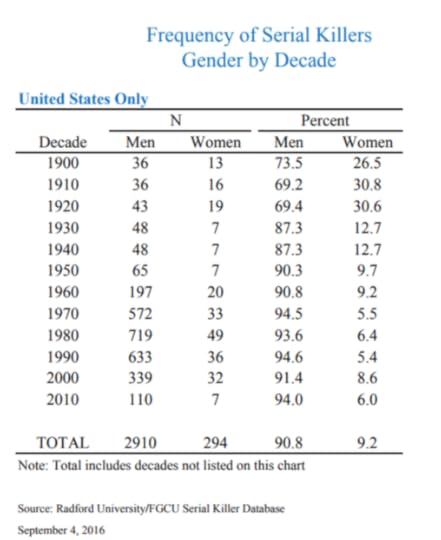
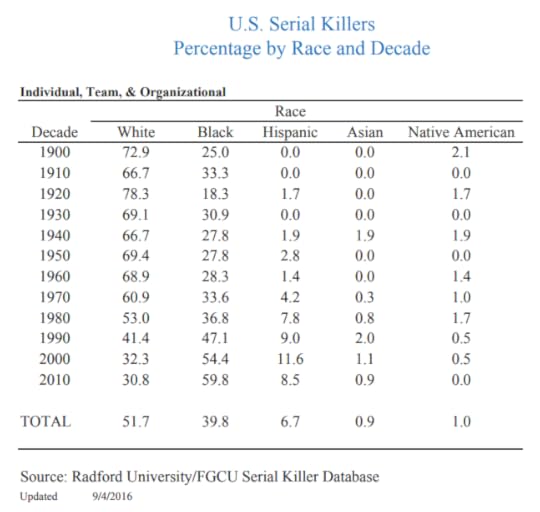 As long as I’m talking about cereal, I’ll mention that John Harvey Kellogg was a physician who was active in the Seventh-day Adventist Church who felt that eating a bland diet would reduce sexual impulsivity. This led to the introduction of Kellogg’s cereal. Prior to the popularity of Kellogg’s cereal, people ate leftovers from supper for breakfast. So next time someone offers you a bowl of cereal, consider the hidden message. Kellogg’s work took off from a theory offered by Presbyterian Minister Sylvester Graham who believed bland snacks could reduce sexual deviance. The Graham cracker was named after him.
As long as I’m talking about cereal, I’ll mention that John Harvey Kellogg was a physician who was active in the Seventh-day Adventist Church who felt that eating a bland diet would reduce sexual impulsivity. This led to the introduction of Kellogg’s cereal. Prior to the popularity of Kellogg’s cereal, people ate leftovers from supper for breakfast. So next time someone offers you a bowl of cereal, consider the hidden message. Kellogg’s work took off from a theory offered by Presbyterian Minister Sylvester Graham who believed bland snacks could reduce sexual deviance. The Graham cracker was named after him.
I have challenged my Sociology students with this discussion question for the last 3 years: “Should we provide Pakistan with billions of dollars in aid when we are also spending a trillion dollars to fight a war in Afghanistan against the Taliban, and the Taliban escapes into Pakistan where they’re protected? Shouldn’t there be some expectation of cooperation, or at least not continual badmouthing of the U.S., as a result of billions of dollars in aid?”
Guess what? Our administration finally asked the same question this week. Good news! Even better, the response from Pakistan was they feel they can have a better relationship with the U.S. now, suggesting they may be more cooperative if the loss of aid becomes an issue.
Remember when we landed a couple of helicopters in Pakistan and killed Osama Bin Laden? Great job military and Obama administration! Pakistan was a little miffed that we didn’t tell them we were paying a visit, but the reality is we can’t trust them. I support the American decision 100%, although I have to admit we would be a little irritated if another country landed helicopters in the U.S., killed a citizen and departed, basically telling us, “Just forget about it and move on.” Evidently Pakistan is now willing to do this.
Kelsi Stuckmeyer went over 1000 points in Pierz girls basketball this week! Congratulations Kelsi—great person, great student, and great basketball player from a great family! Congratulations Marvin and Ruth Stuckmeyer!
Quotes:
On New Year's Eve, Marilyn stood up in the local pub and said that it was time to get ready. At the stroke of midnight, she wanted every person to be standing next to the one person who made their life worth living. Well, it was kind of embarrassing. As the clock struck, the bartender was almost crushed to death.
"Youth is when you're allowed to stay up late on New Year's Eve. Parenting is when you're forced to.” (my modification of a Billy Vaughn quote)
"Now there are more overweight people in America than average-weight people. So overweight people are now average… which means, you have already met your New Year's resolution." Jay Leno
"My wife was afraid of the dark... then she saw me naked and now she's afraid of the light.” Rodney Dangerfield
Thanks for listening,
Frank A visit by Brenda, Pam and Alex to Washington DC







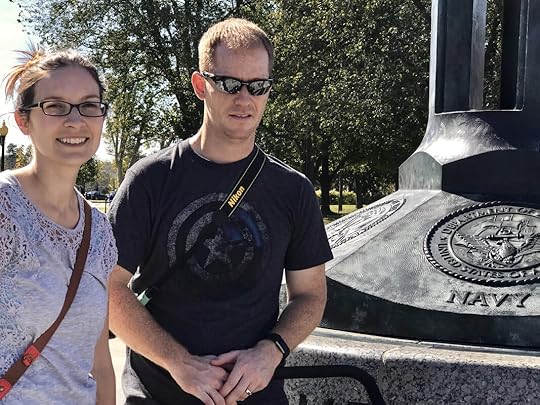







 Christmas at Frank and Brenda’s
Christmas at Frank and Brenda’s 






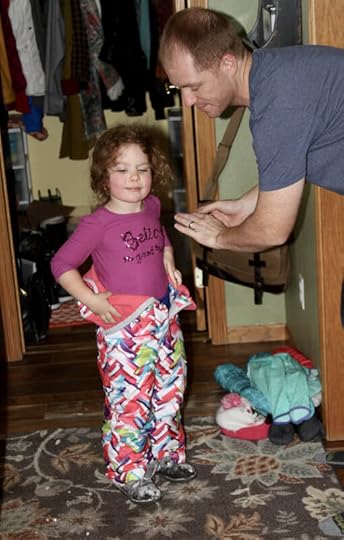






























 The sequel to Murder Book, I-94 Murders, is now finished and at North Star Press. Alicia Isom is the model featured on the cover. I appreciate the suggestions for other titles and covers I’ve received and I’m still mulling them over. We are also still considering book covers. It’s interesting how movies and TV shows emphasize over and over again how serial killers are predominantly white. They are in all the shows, right? It’s actually not true. About 31% of serial killers in the United States are of now of European Ancestry (formerly known as white). About 60% are African American, 8% are Chicano (Hispanic) and 1% are Asian. This suggests to me we have a significant poverty issue in our inner cities that needs to be addressed. I fear sometimes we are missing the seriousness of the problem by ignoring data we have. As a forensic psychologist I believe very strongly in the importance of evidence. It’s very difficult to resolve a problem without understanding the specifics of the problem. The evidence would suggest we have parts of the U.S. that are crazy dangerous.
The sequel to Murder Book, I-94 Murders, is now finished and at North Star Press. Alicia Isom is the model featured on the cover. I appreciate the suggestions for other titles and covers I’ve received and I’m still mulling them over. We are also still considering book covers. It’s interesting how movies and TV shows emphasize over and over again how serial killers are predominantly white. They are in all the shows, right? It’s actually not true. About 31% of serial killers in the United States are of now of European Ancestry (formerly known as white). About 60% are African American, 8% are Chicano (Hispanic) and 1% are Asian. This suggests to me we have a significant poverty issue in our inner cities that needs to be addressed. I fear sometimes we are missing the seriousness of the problem by ignoring data we have. As a forensic psychologist I believe very strongly in the importance of evidence. It’s very difficult to resolve a problem without understanding the specifics of the problem. The evidence would suggest we have parts of the U.S. that are crazy dangerous. An interesting piece of serial killer data is that there are fewer women serial killers today (1/2 as many) as there was in 1900. At the same time, there are 4 times as many men serial killers today as there was in 1900. While women’s rights have progressively improved, women are killing less and men are killing more. One of my female college students suggested that with improved rights, women have less of a need to kill men.
While murder data is concerning, it’s important to keep in mind that it is much better than it was 20 and 30 years ago. In 1980, there were 7 times as many male and 7 times as many female serial killers as there are today. It wasn’t just hair that was bad in the 1980’s.

 As long as I’m talking about cereal, I’ll mention that John Harvey Kellogg was a physician who was active in the Seventh-day Adventist Church who felt that eating a bland diet would reduce sexual impulsivity. This led to the introduction of Kellogg’s cereal. Prior to the popularity of Kellogg’s cereal, people ate leftovers from supper for breakfast. So next time someone offers you a bowl of cereal, consider the hidden message. Kellogg’s work took off from a theory offered by Presbyterian Minister Sylvester Graham who believed bland snacks could reduce sexual deviance. The Graham cracker was named after him.
As long as I’m talking about cereal, I’ll mention that John Harvey Kellogg was a physician who was active in the Seventh-day Adventist Church who felt that eating a bland diet would reduce sexual impulsivity. This led to the introduction of Kellogg’s cereal. Prior to the popularity of Kellogg’s cereal, people ate leftovers from supper for breakfast. So next time someone offers you a bowl of cereal, consider the hidden message. Kellogg’s work took off from a theory offered by Presbyterian Minister Sylvester Graham who believed bland snacks could reduce sexual deviance. The Graham cracker was named after him.I have challenged my Sociology students with this discussion question for the last 3 years: “Should we provide Pakistan with billions of dollars in aid when we are also spending a trillion dollars to fight a war in Afghanistan against the Taliban, and the Taliban escapes into Pakistan where they’re protected? Shouldn’t there be some expectation of cooperation, or at least not continual badmouthing of the U.S., as a result of billions of dollars in aid?”
Guess what? Our administration finally asked the same question this week. Good news! Even better, the response from Pakistan was they feel they can have a better relationship with the U.S. now, suggesting they may be more cooperative if the loss of aid becomes an issue.
Remember when we landed a couple of helicopters in Pakistan and killed Osama Bin Laden? Great job military and Obama administration! Pakistan was a little miffed that we didn’t tell them we were paying a visit, but the reality is we can’t trust them. I support the American decision 100%, although I have to admit we would be a little irritated if another country landed helicopters in the U.S., killed a citizen and departed, basically telling us, “Just forget about it and move on.” Evidently Pakistan is now willing to do this.
Kelsi Stuckmeyer went over 1000 points in Pierz girls basketball this week! Congratulations Kelsi—great person, great student, and great basketball player from a great family! Congratulations Marvin and Ruth Stuckmeyer!
Quotes:
On New Year's Eve, Marilyn stood up in the local pub and said that it was time to get ready. At the stroke of midnight, she wanted every person to be standing next to the one person who made their life worth living. Well, it was kind of embarrassing. As the clock struck, the bartender was almost crushed to death.
"Youth is when you're allowed to stay up late on New Year's Eve. Parenting is when you're forced to.” (my modification of a Billy Vaughn quote)
"Now there are more overweight people in America than average-weight people. So overweight people are now average… which means, you have already met your New Year's resolution." Jay Leno
"My wife was afraid of the dark... then she saw me naked and now she's afraid of the light.” Rodney Dangerfield
Thanks for listening,
Frank A visit by Brenda, Pam and Alex to Washington DC
















 Christmas at Frank and Brenda’s
Christmas at Frank and Brenda’s 



































Published on January 06, 2018 07:15
December 18, 2017
Merry Christmas!
Published on December 18, 2017 12:23
December 15, 2017
Murder Book Sequel
Join Frank at
Once Upon a Crime
this Saturday, December 16, for a meet and greet from 12:00 pm to 2:00 pm. I am in process of finishing my second novel. The working title of this book is "I-94 Murders."
In the “I-94 Murders,” Investigator Jon Frederick is enticed into working a case which involves a serial killer who is stalking couples who access bondage on the internet. The I-94 killer murders the dominant male and assaults the submissive woman, leaving bodies along I-94. Like the Zodiac killer, the I-94 killer writes cyphers to newspapers (presented in a format the reader is invited to work through). Due to the nature of the crimes, it is difficult to ascertain whether the killer is a woman or a man, or a woman and a man working together. Jon knows he is pursuing a well-educated predator who understands investigations. Similar to Murder Book, chapters are written in first person, from different perspectives, allowing the reader to better understand Jon’s struggles and the killer’s motivation. Along with being a thriller, it’s a story of corroding and mending relationships.
I am trying to finalize my title and book cover, and am opening up this blog to suggestions. Here are some of the examples considered. Please feel free to provide feedback, or your own suggestions:
I-94 Murders
The I-94 Killer
Ties that Bind
Safe Word
Tie Died
Road Kill
Boldly Seeking Submission
Xsperience Photography did a great job for us on the cover photo, and thank you to Alicia Isom for modeling. Here are a few of our favorites:







 Thank you in advance for your help!
Thank you in advance for your help!
I was flicking around channels late one weekend night and I found a live Heart concert from the 1970’s. This was a great band who put on an entertaining show. Nancy Wilson is impressive on guitar and I love her signature kick after solos. Ann Wilson has one of my favorite rock voices. I enjoy the emotion some music brings. Kevin Zenner and I were talking about Eric Clapton and Duane Allman-- who got together to record Derek and the Dominos “Layla,” which features Duane Allman on slide guitar in the background. I love when music connects so intensely with emotion. The Derek and the Dominos LP featured a song called Bell Bottom Blues which addressed the despair of losing his blue jean wearing lover with lines like, "Do you want to see me crawl across the floor for you. Do you want me to beg you to take me back?" and, "It's all wrong, but it's alright." Duane Allman was a musician who made everyone around him perform better. He, unfortunately, died at age 24, in 1971, when he lost control of his motorcycle and slid into the side of a flatbed truck in Macon, Georgia. Enjoy this live version of “Crazy on You,” by Heart.
I helped a man of Mexican ancestry today who is a great worker, but he struggles a little with English. He works at a factory and applied for a promotion working on a new machine. He's the guy people go to fix the machines if they aren't working, and he cleans anytime he isn't busy, thinking "anything to help the company." His coworkers thought he was a shoe-in for the job, but instead it went to another guy who has been fired 3 times for being incompetent. I've talked to him about how frustrating situations are opportunities to show we don't respond like everyone else. He was proud of how he handled it.
He went to his boss and asked why he didn't receive the promotion.
His boss responded by teasing, "Your English isn't too good."
He asked his boss to follow him to the machine. He then stood there silent next to it. When his boss started talking he said, "Shhhhhhhhhhhhhhh..."
After a bit his boss said, "You realize this machine doesn't talk?"
He told his boss, "Yeah, I just wanted to make sure you realized this."
Thanks for listening,
Frank
In the “I-94 Murders,” Investigator Jon Frederick is enticed into working a case which involves a serial killer who is stalking couples who access bondage on the internet. The I-94 killer murders the dominant male and assaults the submissive woman, leaving bodies along I-94. Like the Zodiac killer, the I-94 killer writes cyphers to newspapers (presented in a format the reader is invited to work through). Due to the nature of the crimes, it is difficult to ascertain whether the killer is a woman or a man, or a woman and a man working together. Jon knows he is pursuing a well-educated predator who understands investigations. Similar to Murder Book, chapters are written in first person, from different perspectives, allowing the reader to better understand Jon’s struggles and the killer’s motivation. Along with being a thriller, it’s a story of corroding and mending relationships.
I am trying to finalize my title and book cover, and am opening up this blog to suggestions. Here are some of the examples considered. Please feel free to provide feedback, or your own suggestions:
I-94 Murders
The I-94 Killer
Ties that Bind
Safe Word
Tie Died
Road Kill
Boldly Seeking Submission
Xsperience Photography did a great job for us on the cover photo, and thank you to Alicia Isom for modeling. Here are a few of our favorites:








 Thank you in advance for your help!
Thank you in advance for your help!
I was flicking around channels late one weekend night and I found a live Heart concert from the 1970’s. This was a great band who put on an entertaining show. Nancy Wilson is impressive on guitar and I love her signature kick after solos. Ann Wilson has one of my favorite rock voices. I enjoy the emotion some music brings. Kevin Zenner and I were talking about Eric Clapton and Duane Allman-- who got together to record Derek and the Dominos “Layla,” which features Duane Allman on slide guitar in the background. I love when music connects so intensely with emotion. The Derek and the Dominos LP featured a song called Bell Bottom Blues which addressed the despair of losing his blue jean wearing lover with lines like, "Do you want to see me crawl across the floor for you. Do you want me to beg you to take me back?" and, "It's all wrong, but it's alright." Duane Allman was a musician who made everyone around him perform better. He, unfortunately, died at age 24, in 1971, when he lost control of his motorcycle and slid into the side of a flatbed truck in Macon, Georgia. Enjoy this live version of “Crazy on You,” by Heart.
I helped a man of Mexican ancestry today who is a great worker, but he struggles a little with English. He works at a factory and applied for a promotion working on a new machine. He's the guy people go to fix the machines if they aren't working, and he cleans anytime he isn't busy, thinking "anything to help the company." His coworkers thought he was a shoe-in for the job, but instead it went to another guy who has been fired 3 times for being incompetent. I've talked to him about how frustrating situations are opportunities to show we don't respond like everyone else. He was proud of how he handled it.
He went to his boss and asked why he didn't receive the promotion.
His boss responded by teasing, "Your English isn't too good."
He asked his boss to follow him to the machine. He then stood there silent next to it. When his boss started talking he said, "Shhhhhhhhhhhhhhh..."
After a bit his boss said, "You realize this machine doesn't talk?"
He told his boss, "Yeah, I just wanted to make sure you realized this."
Thanks for listening,
Frank
Published on December 15, 2017 07:26

 Meg King Abraham, Frank, and Krista Soukup Rolfzen at Once Upon a Crime bookstore
Meg King Abraham, Frank, and Krista Soukup Rolfzen at Once Upon a Crime bookstore  "Nothing But A Child"
"Nothing But A Child"

